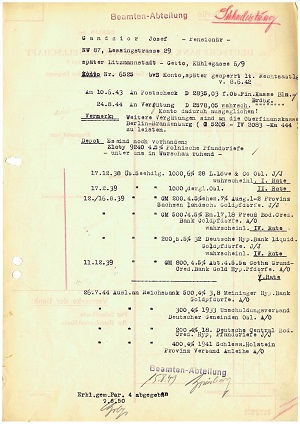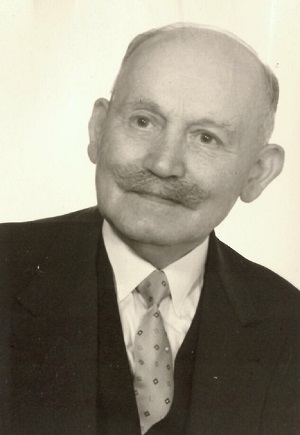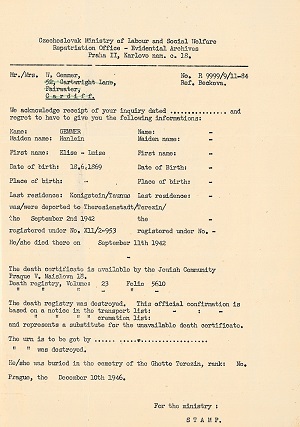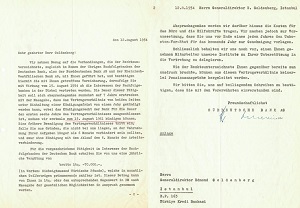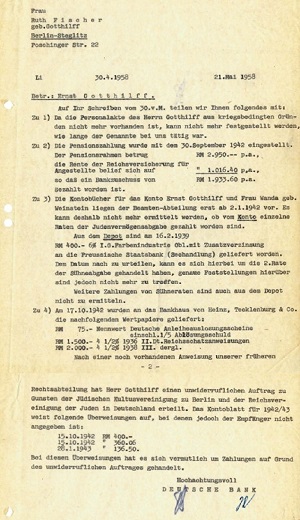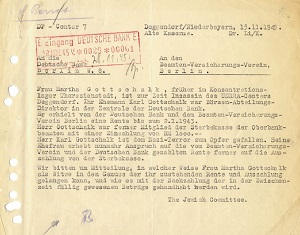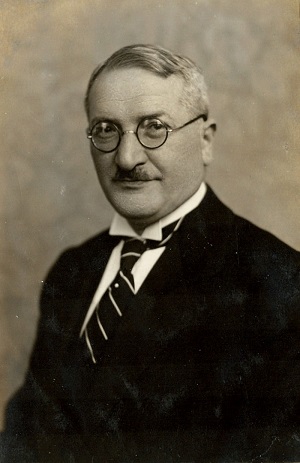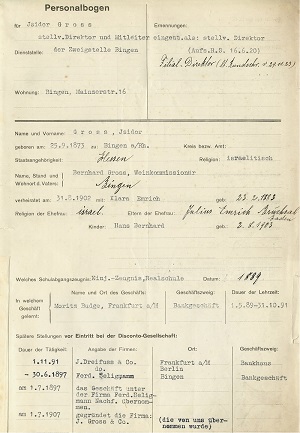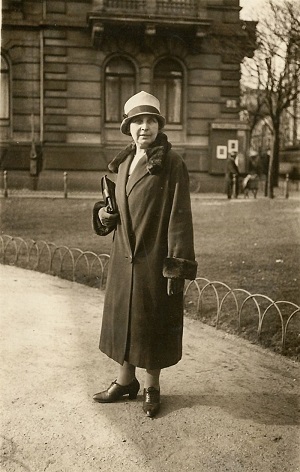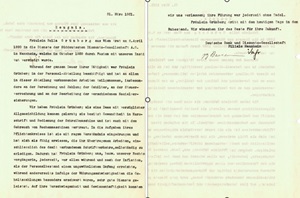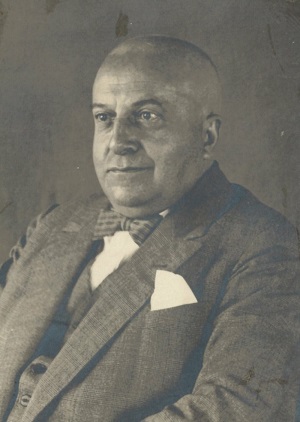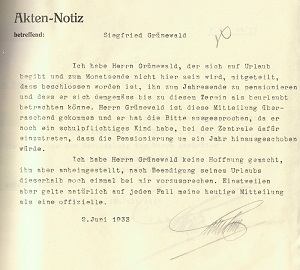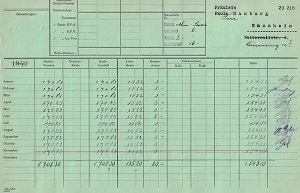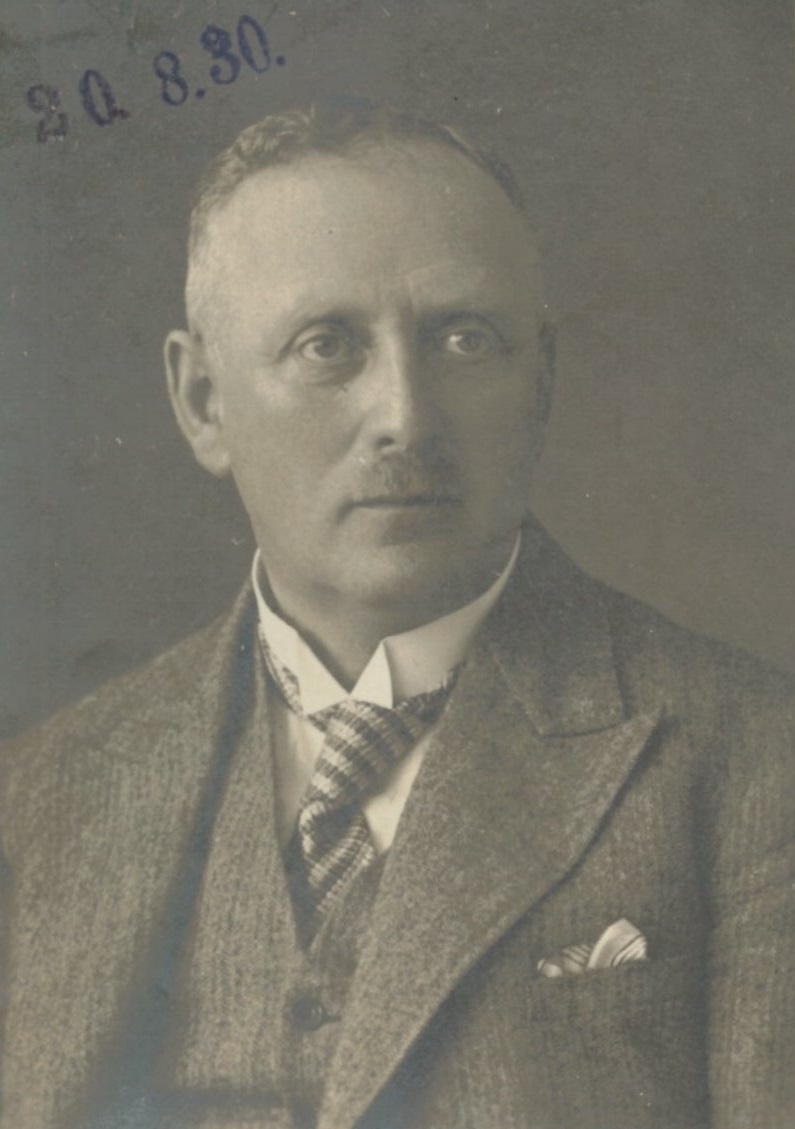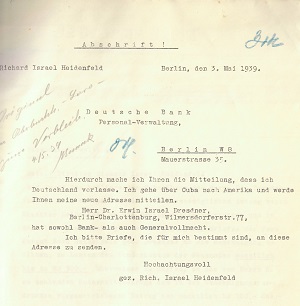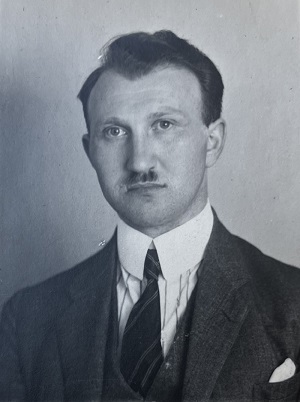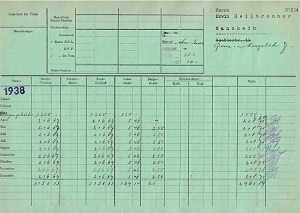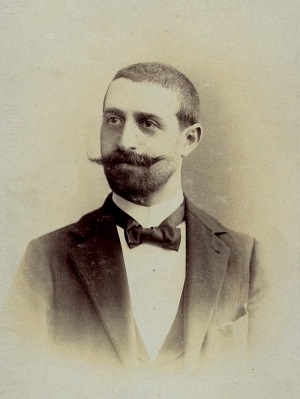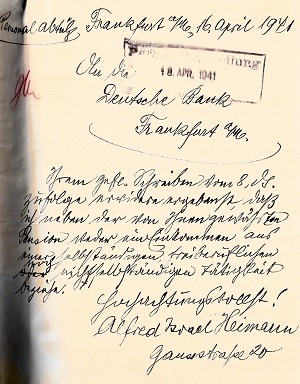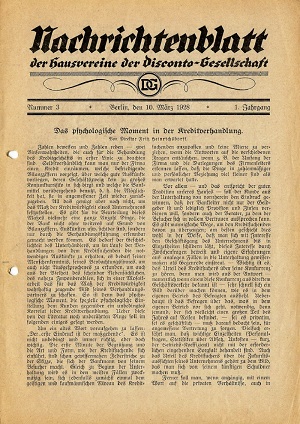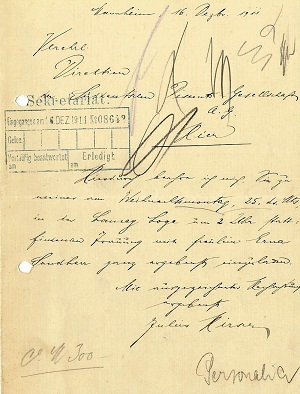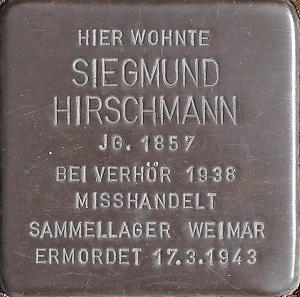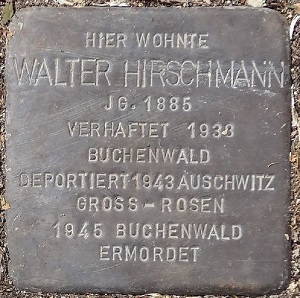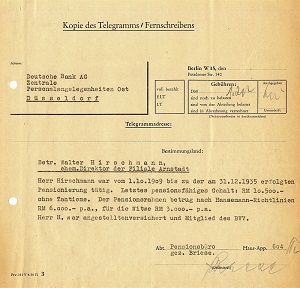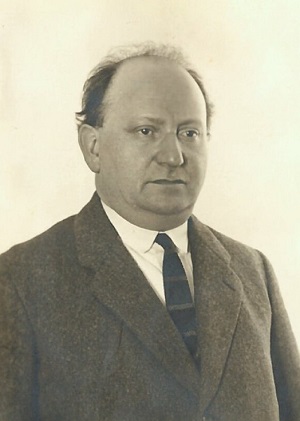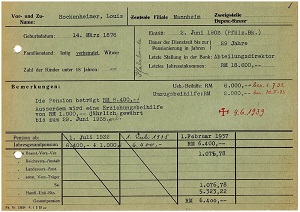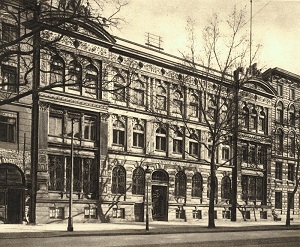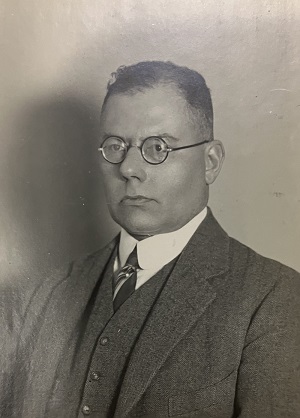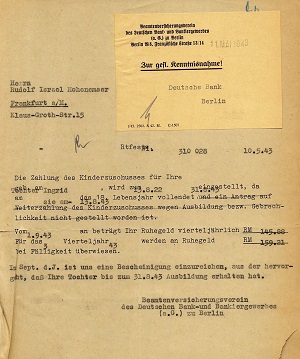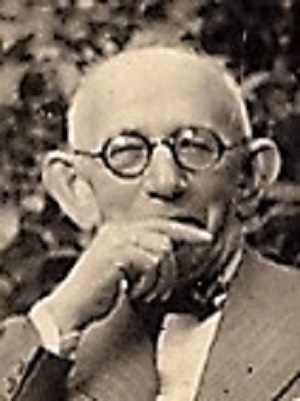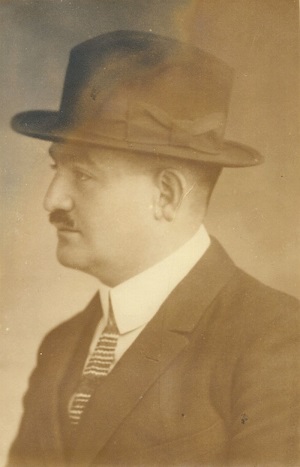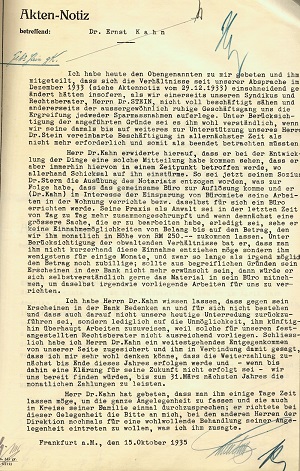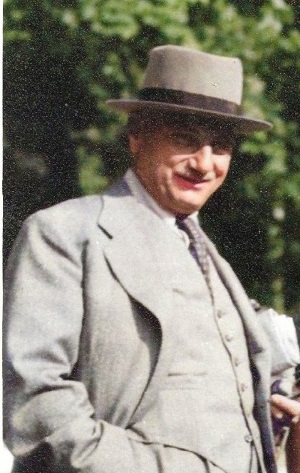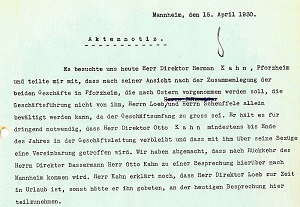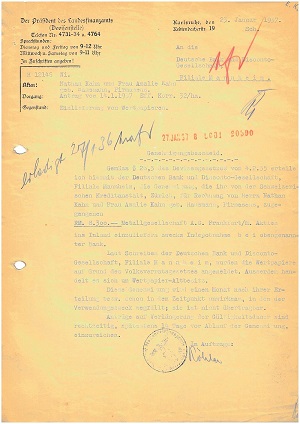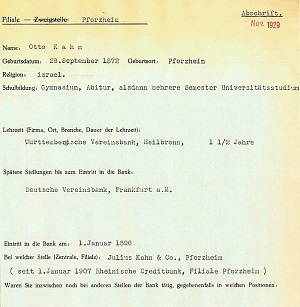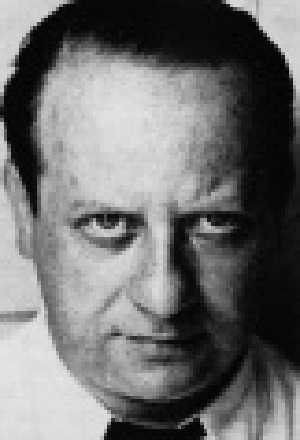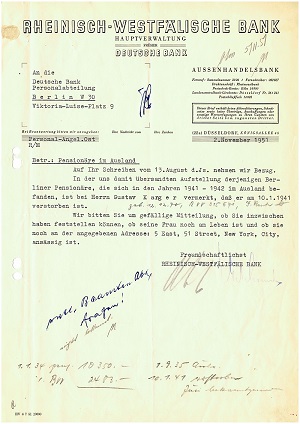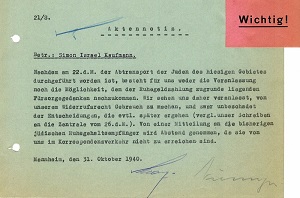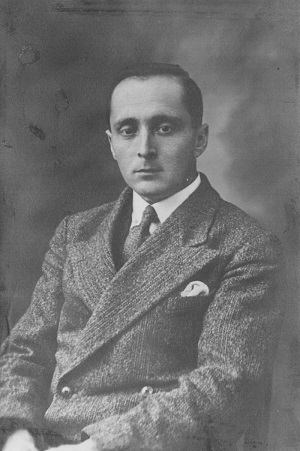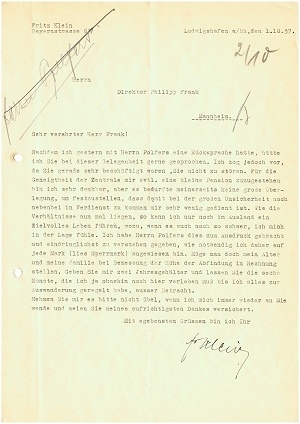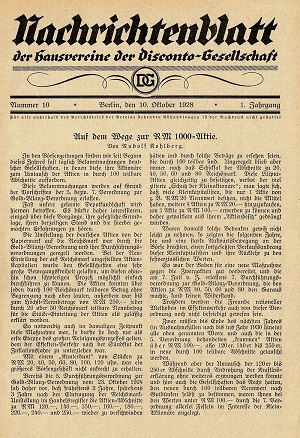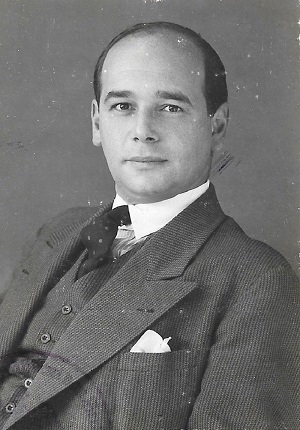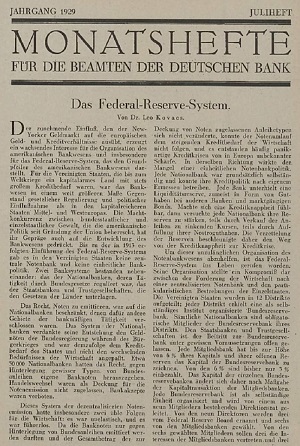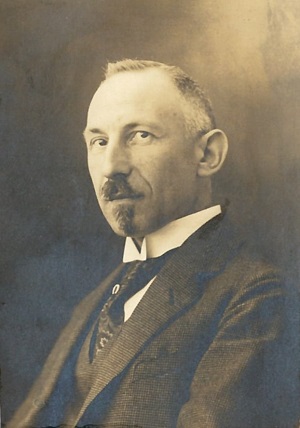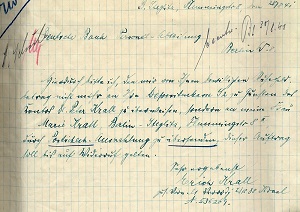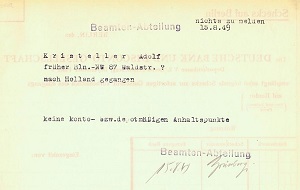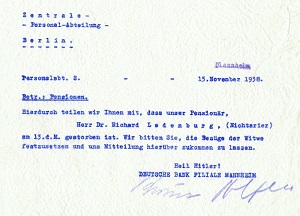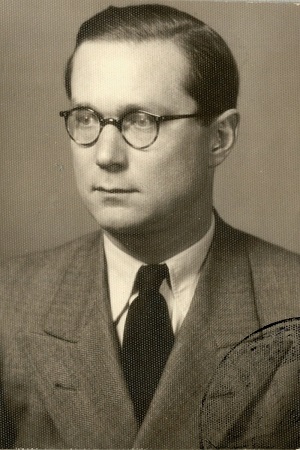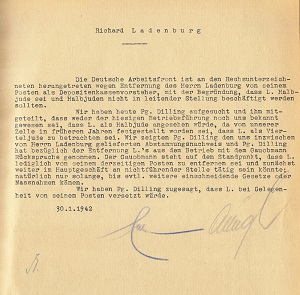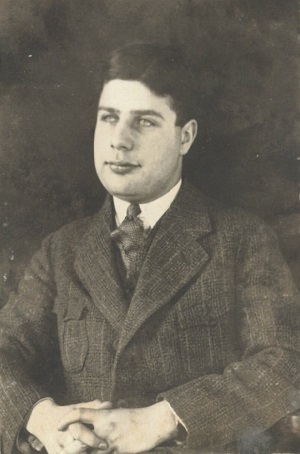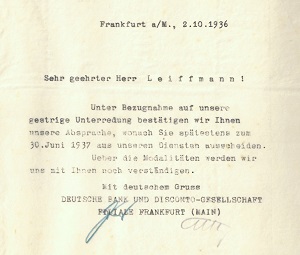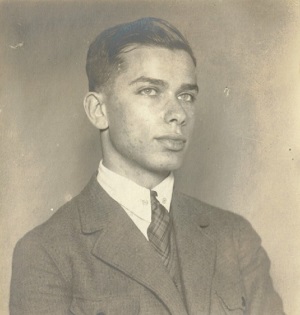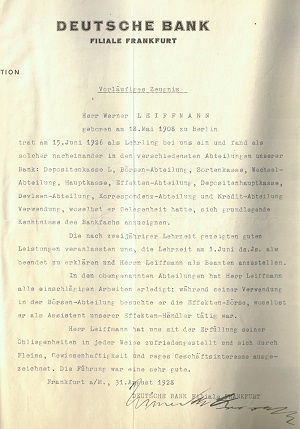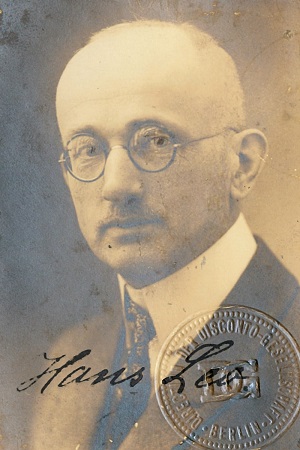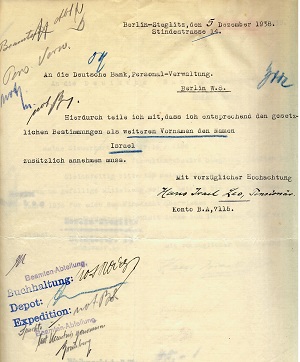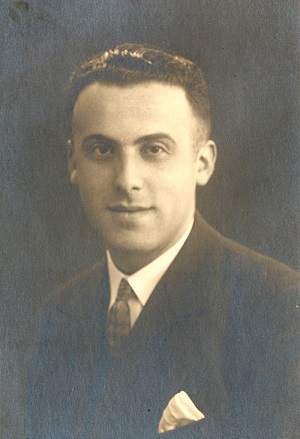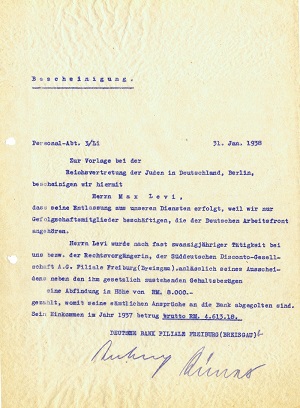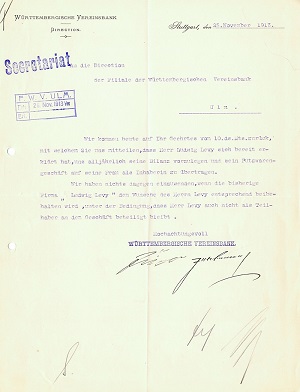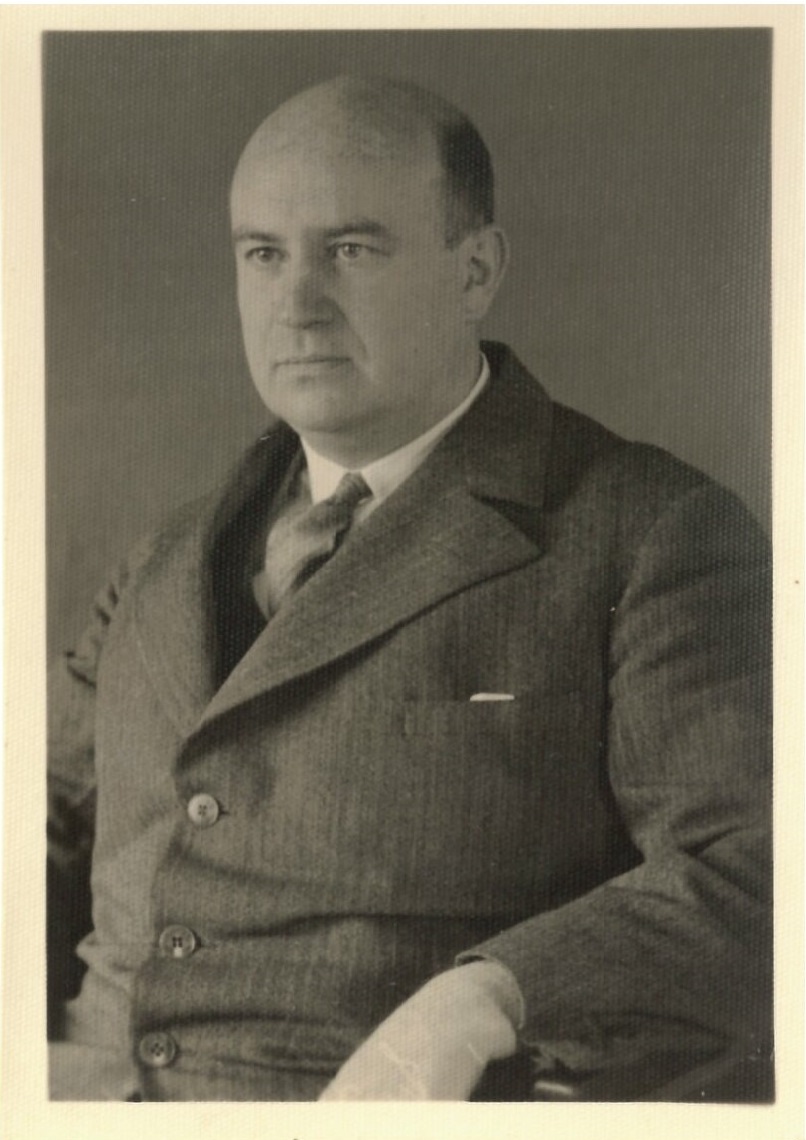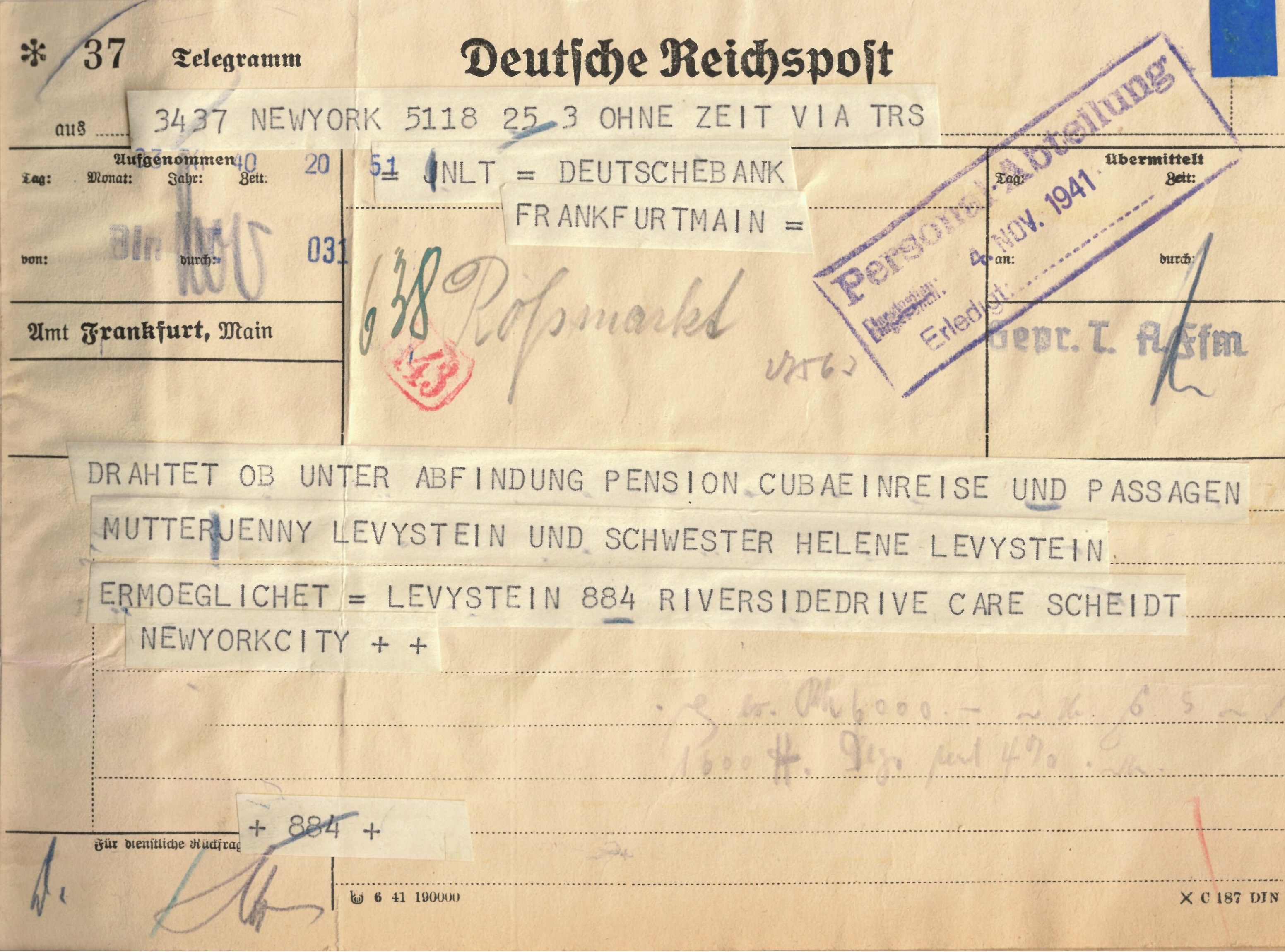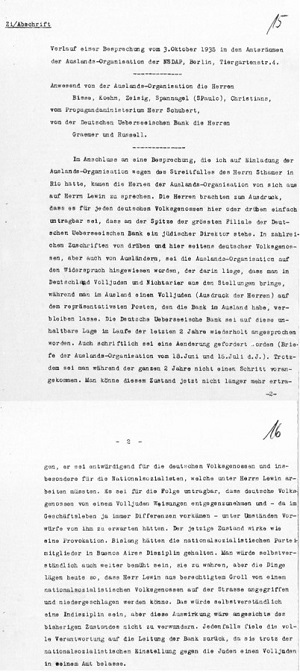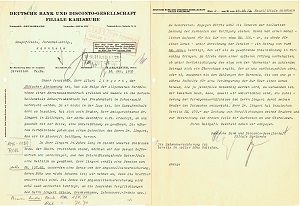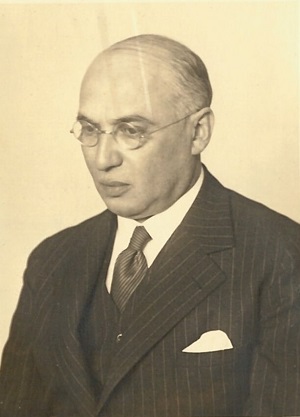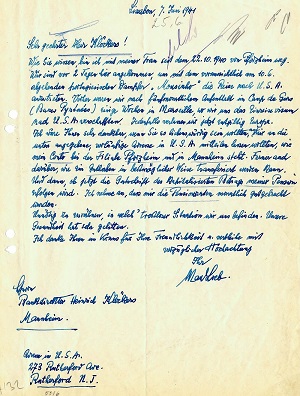Show content of Gandzior, Josef
| first name(s), surname: | Josef Gandzior | ||
| day of birth: | 15.06.1885 | ||
| birthplace: | Łabędy nearby Gliwice | ||
| day of death: | unknown | ||
| place of death: | Kulmhof (Chełmno) | ||
| document: |
|
||
| life: | Josef Gandzior came from a Jewish family from Upper Silesia. His parents were Moritz Gandzior (5 July 1858 in Rybnik - 2 April 1937) and Bertha, née Blumenfeld (10 April 1868 in Peiskretscham - 6 May 1940 in Gleiwitz). Nothing is known about his school and professional education. He is first mentioned as an employee of Disconto-Gesellschaft in Berlin in 1928, where he worked in the letters of credit department. After the merger of Disconto-Gesellschaft with Deutsche Bank in October 1929, he worked in the Berlin head office of the merged institution in the department "Reich-Banken". As a holder of power of attorney he was responsible for day-to-day business with domestic banks with the letters O-Z. He is last mentioned in this position at the end of 1936. Because of his Jewish origin, he was forced into early retirement in 1937/38. His annual pension was 3,600 Reichsmark. Josef Gandzior was married to Frieda, née Hamburger (15 November 1885 in Sorau - 9 May 1942 in Kulmhof (Chełmno)). The couple was deported to Lodz on 1 November 1941, on the 4th transport from Berlin. On 9 May 1942, Josef and Bertha Gandzior were deported from Lodz to the Kulmhof (Chełmno) extermination camp and murdered there. Their assets were confiscated and seized by the Nazi state. The only surviving family member was Josef Gandzior's sister Margot Jacoby née Gandzior (3 April 1905 in Gleiwitz - 19 February 2002), who initiated restitution proceedings in the 1950s. Margot Jacoby had initially worked for Disconto-Gesellschaft Gleiwitz branch in the late 1920s, and from October 1929 for Deutsche Bank und Disconto-Gesellschaft Gleiwitz branch. |
||
| joined Deutsche Bank (or precursor): | unknown (joined Disconto-Gesellschaft) | ||
| end of employment: | probably 1937/38 | ||
| career: | unknown - 29.10.1929 Disconto-Gesellschaft Berlin 29.10.1929 - ca. 1937 Deutsche Bank und Disconto-Gesellschaft department Reich-Banken (holder of power of attorney) |
||
| last known address: | Berlin-Tiergarten, Lessingstrasse 29; Lodz, Kühlegasse 6/9 | ||
| transport: | 01.11.1941 from Berlin to Lodz / Litzmannstadt 09.05.1942 from Lodz / Litzmannstadt to Chełmno / Kulmhof |
||
| archival sources: | HADB, B377; HADB, DB(alt)/0963 | ||
| literature: | Josef Gandzior, Das Reise-Akkreditiv, in: Nachrichtenblatt der Hausvereine der Disconto-Gesellschaft, 1928, no.12, pp. 245-246 | ||
| links: |
https://blha-digi.brandenburg.de/rest/dfg/ondRlvNOVOGXCOhj https://www.bundesarchiv.de/gedenkbuch/de1054324 |
Show content of Gemmer, Wilhelm
| first name, surname: | Wilhelm Gemmer |
| day of birth: | 06.05.1880 |
| birthplace: | Singhofen |
| day of death: | 14.04.1971 |
| place of death: | Königstein |
| photo / document: | |
| life: |
Wilhelm Gemmer was born in Singhofen near Nassau in 1880. He was a Protestant, but converted to the Jewish faith when he married his wife Luise. In 1906 he joined Disconto-Gesellschaft and after the merger with Deutsche Bank in 1929 worked in the accounting department of Deutsche Bank und Disconto-Gesellschaft Frankfurt branch. On 1 October 1931 he retired for health reasons at the age of 51. Gemmer emigrated to Great Britain in August 1939, where he was interned in Douglas on the Isle of Man in 1940. He returned to his old home at Kirchstraße 12 in Königstein after the Second World War, where he died at the age of 90. His wife was murdered in Theresienstadt in 1942 and his daughter in Auschwitz one year later. |
| joined Deutsche Bank (or precursor): | 15.06.1906 (Disconto-Gesellschaft) |
| end of employment: | 30.09.1931 |
| career: | 15.06.1906 - 29.10.1929 Disconto-Gesellschaft, Frankfurt branch 29.10.1929 - 30.09.1931 Deutsche Bank und Disconto-Gesellschaft, Frankfurt branch (accountant) |
| last known address: | Königstein, Kirchstraße 12 (returned after WWII) |
| emigration/transport: | in August 1939 to the UK; 1940 interned in Douglas (Isle of Man) |
| archival sources: | HADB, P03/G0133; HADB, P03/G0107 |
| link: |
https://yvng.yadvashem.org/nameDetails.html?language=de&itemId=11503935&ind=1 https://yvng.yadvashem.org/nameDetails.html?language=de&itemId=11503936&ind=1 |
Show content of Goldenberg, Edmond
Show content of Gotthilff, Ernst
| first name(s), surname: | Ernst Gotthilff | ||
| day of birth: | 25.05.1870 | ||
| birthplace: | Rummelsburg (Pomerania), today Miastko | ||
| day of death: | 26.02.1943 | ||
| place of death: | Theresienstadt | ||
| document: |
|
||
| life: | Ernst Gotthilff came from a Jewish family from Rummelsburg in Pomerania (today Miastko in Poland). His father was the doctor Siegfried Gotthilff from Thorn; his mother’s name is unknown. His schooling and professional training are also unknown. He is first documented as a bank clerk in Berlin in 1898. Presumably, he was already working for Deutsche Bank at this time. Documents about his work for the bank have not survived. It is likely that he worked in one of the numerous Berlin city-branches. Whether his departure from the bank around 1933 was due to his Jewish origin or to the general age-related staff reductions as a result of the banking crisis can not be determined. Gotthilff received an annual pension of 2,950 Reichsmarks, which suggests previous employment in the lower wage bracket. In order to improve his pension, Gotthilff worked for the Scherl-Verlag , which published the Berliner Lokal-Anzeiger, where he was responsible for the annual financial statements. Ernst Gotthilff was married to Wanda, née Weinstein (20 December 1871 in Jägerndorf/Krnov - 14 April 1943 in Theresienstadt). Their daughter Ruth was born on 3 March 1902. The family lived at Beckerstrasse 24 in Berlin-Schöneberg from 1909 at the latest. Ruth Gotthilff married the painter and decorator Gottfried Fischer and survived the Nazi era in a so-called privileged mixed marriage. The couple lived at Poschingerstrasse 20 in Berlin-Steglitz. In 1942, Ernst and Wanda Gotthilff had to leave their apartment on Beckerstrasse. They moved in close proximity to their daughter at Poschingerstrasse 16, where they sublet from the widow Frieda Rebhun. Ernst and Wanda Gotthilff had concluded a so-called "Heimkaufvertrag" (home purchase agreement), which was supposed to cover the costs of lifelong accommodation in the Theresienstadt ghetto. They had to transfer all their remaining assets to a special account with the bank Heinz Tecklenburg & Co. At the end of September 1942, pension payments were discontinued. On 14 September 1942, the couple was deported to Theresienstadt with the 65th Berlin transport together with 1,000 people. Of these, only 57 were still alive at the end of the war. Ernst Gotthilff died on 26 February 1943 as a result of the malnutrition, cold, and disease prevalent in the ghetto. His wife survived him by just under two months. |
||
| joined Deutsche Bank: | around 1898 | ||
| end of employment: | around 1933 | ||
| career: | around 1898 - 29.10.1929 Deutsche Bank Berlin 29.10.1929 - around 1933 Deutsche Bank und Disconto-Gesellschaft Berlin around 1933 - unknown Berliner Lokal-Anzeiger |
||
| last known address: | Berlin-Schöneberg, Beckerstrasse 24, "Stolperstein" (literally “stumbling stone or block”, metal cobblestone commemorating an individual victim of Nazism) laid 16 June 2010; 1942 Berlin-Steglitz, Poschingerstrasse 16 | ||
| transport: | to Theresienstadt on 14.09.1942 | ||
| archival sources: | HADB, B377; HADB, DB(alt)/0963 | ||
| literature: | Theresienstädter Gedenkbuch. Die Opfer der Judentransporte aus Deutschland nach Theresienstadt 1942-1945, Prague 2000, p. 68. | ||
| links: |
https://www.stolpersteine-berlin.de/de/beckerstr/24/ernst-gotthilff |
Show content of Gottschalk, Karl
| first name(s), surname: | Karl (Carl) Gottschalk | ||
| day of birth: | 30.06.1872 | ||
| birthplace: | Eisleben | ||
| day of death: | 15.01.1943 | ||
| place of death: | Theresienstadt | ||
| document: |
|
||
| life: | Karl Gottschalk was born in Eisleben in 1872 as the son of the banker Adolf (Wolf) Gottschalk (7 June 1837 - 22 August 1894) and his wife Rosalie née Posner (4 February 1843 - 22 February 1920). Adolf Gottschalk was co-owner of the private bank Gottschalk & Heilbrun in Eisleben, founded in 1885. Nothing is known about Karl Gottschalk's schooling and training, as his personnel file was burned during the air raid on Berlin on 23 November 1943, which heavily damaged the buildings of Deutsche Bank's Berlin head office. Gottschalk's entry into Deutsche Bank must have taken place around 1901; from 1920 he was holder of power of attorney and from 1924 he was director of the stock exchange department of the Berlin head office. He remained in this position until his early retirement on 1 July 1931, which was probably related to the general reduction in personnel following the merger with Disconto-Gesellschaft in October 1929. Karl Gottschalk was married to Martha née Lax (7 April 1877 - 17 June 1959). Their son Wolfgang (Winston) was born on 13 June 1909 in Berlin-Charlottenburg. With the Nazi takeover, the family was increasingly affected by the measures against the Jewish population. The son managed to escape to the United States via Southampton on 18 November 1936. He lived in Lancaster, Pennsylvania, where he died on 16 November 1989. His parents remained in Berlin. Their considerable fortune, which consisted mainly of securities, gradually fell entirely to the state. By 1942 at the latest, they had to move to Mommsenstrasse 55, where only Jewish tenants and subtenants were forcibly housed. On 12 January 1943, Karl Gottschalk and his wife were deported on transport 1/83 from Berlin to the Theresienstadt concentration camp, where they arrived the same day. Karl Gottschalk died three days later. His widow survived Theresienstadt. In November 1945, she was in the UNRRA camp for displaced persons in Deggendorf. She later managed to emigrate to the United States to be with her son. She died in 1959 in Lancaster, Pennsylvania. |
||
| joined Deutsche Bank (or precursor): | around 1901 | ||
| end of employment: | retired 01.07.1931 | ||
| career: | around 1901 - 1924 Deutsche Bank Berlin head office (from 1920 at the latest holder of power of attorney) around 1924 - 29.10.1929 Deutsche Bank Berlin head office, stock exchange department (director) 29.10.1929 - 30.06.1931 Deutsche Bank und Disconto-Gesellschaft Berlin head office, stock exchange department (director) |
||
| last known address: | Berlin-Charlottenburg, Mommsenstrasse 55 | ||
| transport: | Transport 1/83 from Berlin to Theresienstadt on 12.01.1943 | ||
| archival sources: | HADB, P02/G0269 | ||
| literature: | Theresienstädter Gedenkbuch. Die Opfer der Judentransport aus Deutschland nach Theresienstadt 1942-1945, Prague 2000, p. 69 | ||
| links: |
https://www.bundesarchiv.de/gedenkbuch/de1060749 https://zwangsraeume.berlin/en/houses/mommsenstrasse-55 |
Show content of Gross, Isidor
| first name(s), surname: | Isidor Gross | ||||
| day of birth: | 25.09.1873 | ||||
| birthplace: | Bingen | ||||
| day of death: | 19.01.1950 | ||||
| place of death: | Petrópolis, Brazil | ||||
| photo/document: |
|
||||
| life: |
Isidor Gross was the son of the wine merchant Bernhard Gross (1840-1901) and Bertha née Seligmann (1841-1901). The couple, who settled in Bingen after their marriage, had two daughters and three sons. Isidor was the fourth-born. After graduating from secondary school in Bingen, Isidor completed a banking apprenticeship at the Frankfurt privat bank Moritz Budge, and then worked as a clerk at the private bank J. Dreyfus & Co. from 1891 to 1897, also in Frankfurt. In 1897, Isidor became co-owner of the private bank Ferd. Se(e)ligmann Nachf. in Bingen, which he managed together with his cousin Emil J. Seligmann (1863-1942). Their uncle Ferdinand Seligmann, the main owner and namesake of the company, died on 21 November 1906 after a long and serious illness. As he did not include Isidor Gross in his will, the latter left the company and founded the banking house J. Gross & Co. in Bingen in 1907. Emil J. Seligmann continued to run the Seligmann bank under his own name. In 1920, the firm Emil J. Seligmann was taken over by Deutsche Bank, continued as its Bingen branch, but closed in 1926 due to lack of profitability. |
||||
| joined Deutsche Bank (or precursor): | 01.07.1907 | ||||
| end of employment: | 31.12.1930 | ||||
| career: | 01.07.1897 - 30.06.1907 private bank Ferd. Se(e)ligmann Nachf., Bingen,co-owner with his cousin Emil J. Seligmann 01.07.1907 - 01.07.1920 private bank J. Gross & Co., Bingen, co-owner with his brother Karl Gross 1920 - 31.10.1929 Disconto-Gesellschaft Bingen branch, director 01.11.1929 - 31.12.1930 Deutsche Bank und Disconto-Gesellschaft Bingen branch, director |
||||
| last known address: | Stuttgart, Rotenwaldstrasse 45 IIb | ||||
| emigration: | June 1939 to Brazil | ||||
| archival sources: | HADB, P1/136; HADB P1/140; HADB, P1; P1/151; HADB, P1/180; HADB, P51/G1 | ||||
| literature: | Mathilde Mayer, Die alte und neue Welt. Erinnerungen meines Lebens (= Arbeitskreis jüdisches Bingen vol. 6), 3. ed., Bingen 2018. | ||||
| link: |
https://www.juedisches-bingen.de/arbeitskreis/publikationen/buecher.html https://www.ancestry.com/genealogy/records/isidor-gross-24-1z6w31v |
Show content of Grünberg, Bella
| first name(s), surname: | Bella Grünberg | ||||
| day of birth: | 03.01.1868 | ||||
| birthplace: | Vienna | ||||
| day of death: | after August 1942 | ||||
| place of death: | Treblinka | ||||
| photo/document: |
|
||||
| life: |
Isabella (Bella) Grünberg came from a Jewish family in Vienna. Her father, Arnold Aron Grünberg (28 February 1840 in Brody (near Lviv) - 29 October 1880 in Vienna), was the director of a glass factory in Vienna. Her mother was Fanni Grünberg-Tafler née Manheimer (born 1845 in Fürth). She attended the higher girls' school and the commercial school in Vienna and completed a preparatory course as a teacher of French. From 1891 to 1919, she worked as a governess and housekeeper for upper-class families in Vienna, Bamberg and Mannheim. In spring 1920, she joined Süddeutsche Disconto-Gesellschaft in Mannheim as an employee, where she worked in the personnel department. She conducted correspondence independently and was valued for her "excellent general education" and her work ethic during hyperinflation. When Süddeutsche Disconto-Gesellschaft merged into the newly formed Deutsche Bank und Disconto-Gesellschaft in October 1929, Bella Grünberg was taken over by its Mannheim branch. The general staff reduction following the merger and the global economic crisis led to her retirement on 1 April 1931. She received a transitional allowance of 1000 Reichsmark and an annual pension of 1600 Reichsmark. |
||||
| joined Deutsche Bank (or precursor): | 06.04.1920 (Süddeutsche Disconto-Gesellschaft, Mannheim) | ||||
| end of employment: | 01.04.1931 | ||||
| career: | 01.02.1891 - 30.06.1893 banker S. Simons, Mannheim (governess) 01.01.1895 - 30.06.1905 private tutor in Vienna 01.01.1906 - 30.06.1912 merchant M. Strauss, Bamberg (governess and head of household) 01.12.1912 - 31.01.1919 Councillor of Commerce Eduard Schweitzer, Mannheim (companion and housekeeper) 06.04.1920 - 29.10.1929 Süddeutsche Disconto-Gesellschaft, Mannheim (clerk in the personnel department) 30.10.1929 - 31.03.1931 Deutsche Bank und Disconto-Gesellschaft Mannheim branch (clerk in the personnel department, most recently salary group II, 15th year of professional experience) |
||||
| last known address: | Vienna, Albertgasse 24/II/19, c/o Dr. Wertheimer; from 1941 Vienna, Sterngasse 2/IV/27 | ||||
| transports: | from Vienna to Theresienstadt (transport IV/7) on 14.08.1942; from Theresienstadt to Treblinka on 26.09.1942 | ||||
| archival sources: | HADB, P33/G0018; HADB, F028/0687 | ||||
| links: |
https://www.holocaust.cz/de/opferdatenbank/opfer/51372-isabella-gr-nberg/ https://www.geni.com/people/Isabella-Bella-Gr%C3%BCnberg/6000000031095720843 |
Show content of Grünewald, Siegfried
| first name(s), surname: | Siegfried Grünewald | ||||
| day of birth: | 20.07.1877 | ||||
| birthplace: | Frankfurt am Main | ||||
| day of death: | 17.06.1943 | ||||
| place of death: | Frankfurt am Main | ||||
| photo / document: |
|
||||
| life: | The son of a beer merchant spent his entire life in Frankfurt am Main. After an apprenticeship in the private banking house Gebrüder Neustadt from 1892 to 1894, he was employed there until 1907, before joining the Disconto-Gesellschaft, for which, interrupted only by military service in the First World War, he remained active even after its merger with Deutsche Bank until his forced retirement at the end of 1933. His marriage to a non-Jewish woman saved him from deportation. | ||||
| joined Deutsche Bank (or precursor): | 12.01.1907 | ||||
| end of employment: | 31.12.1933 | ||||
| career: | 12.01.1907 - 1910 Disconto-Gesellschaft, Frankfurt branch (correspondence department) 1910 - 1913 Disconto-Gesellschaft, Frankfurt branch (securities department) 1913 - 1916 Disconto-Gesellschaft, Frankfurt branch (cashier of city sub branches) 1918 - 1920 Disconto-Gesellschaft, Frankfurt branch (head of securities department) 1920 - 1924 Disconto-Gesellschaft, Frankfurt branch (head of city sub branch Mainzer Landstraße) 1924 - 1928 Disconto-Gesellschaft, Frankfurt branch (head of city sub branch Konstablerwache) 01.04.1928 attorney 1928 - 29.10.1929 Disconto-Gesellschaft, Frankfurt branch (supervisor of all Frankfurt city sub branches) 29.10.1929 - 31.12.1933 Deutsche Bank und Disconto-Gesellschaft, Frankfurt branch (supervisor of all Frankfurt city sub branches) |
||||
| last known address: | Frankfurt am Main, Eschersheimer Landstraße 132 | ||||
| archival sources: | HADB, P03/G0400; HADB, P03/G0509; HADB P03/G0521 |
Show content of Hamburg, Paula
| first name(s), surname: | Paula Hamburg | ||
| day of birth: | 06.07.1887 | ||
| birthplace: | Mainz | ||
| day of death: | unknown | ||
| place of death: | Auschwitz | ||
| document: |
|
||
| life: | Paula Hamburg came from Mainz. Her family background and her educational and professional career are unknown. In the 1930s, she was employed as a clerk at the Mannheim branch of Deutsche Bank und Disconto-Gesellschaft and was lastly classified in salary group 3. At the end of March 1937, she was prematurely retired due to her Jewish heritage. She received a transitional allowance of 1200 Reichsmark and a monthly pension of 170.83 Reichsmark, which was paid until October 1940. Paula Hamburg, who remained unmarried, continued to live in Mannheim until 22 October 1940 (from 1939 at Luisenring 12a). On this day, like many Baden and Saar-Palatinate Jews, she was deported to the Gurs internment camp in southwestern France. From there, she was later taken to the Drancy assembly camp near Paris and deported to Auschwitz on 10 August 1942. When she was murdered there is unknown. |
||
| joined Deutsche Bank (or precursor): | unknown | ||
| end of employment: | 31.03.1937 | ||
| career: | unknown - 31.03.1937 Deutsche Bank und Disconto-Gesellschaft Mannheim branch (clerk classified in salary group 3) | ||
| last known address: | Mannheim, Tattersallstrasse 4; (from 1939) Mannheim, Luisenring 12a | ||
| transports: | to Gurs on 22.10.1940, in Drancy until 10.08.1942, to Auschwitz on 10.08.1942 | ||
| archival sources: | HADB, B381; HADB, F28/688 | ||
| links: |
Show content of Heidenfeld, Richard
| first name(s), surname: | Richard Heidenfeld | ||||
| day of birth: | 14.03.1882 | ||||
| birthplace: | Gleiwitz (Gliwice) | ||||
| day of death: | 27.05.1954 | ||||
| place of death: | London | ||||
| photo / document: |
|
||||
| life: |
Richard Heidenfeld was born in 1882 as the son of the factory owner Isaac Heidenfeld in Gleiwitz. After an apprenticeship and subsequent employment at the Breslau Disconto Bank in Gleiwitz, he helped to build up the Leipzig branch of the Dresdner Bank from 1909. His work at Dresdner Bank was interrupted by five months of military service in the First World War. In 1922 he was then appointed director of the Disconto-Gesellschaft Leipzig branch, but returned to Leipzig eight years later as branch director. According to a note from the personnel department, not only his good knowledge of the banking centre but also his religion played a role in filling the post of director - the business owners of Disconto-Gesellschaft were also largely of Jewish origin. Shortly afterwards, in the course of the merger of Disconto-Gesellschaft with Deutsche Bank, Heidenfeld was appointed director of the Berlin headquarters of Deutsche Bank and Disconto-Gesellschaft. At the end of 1937, the board of the Deutsche Bank took the decision to dismiss Heidenfeld because of his Jewish origin. As a result, he was given leave of absence in April 1938 and retired early in 1939 at the age of 57. Heidenfeld left Germany in May 1939 with his wife Adelheid by ship, the Iberia, to emigrate to the USA via Cuba. In Cuba, the couple was interned for ten weeks and then sent back to Europe. In this way, the couple arrived in London involuntarily. Although Heidenfeld stuck to his plans to emigrate to the USA, he ultimately remained in London until his death in 1954. He used his Deutsche Bank pension payments to support various family members and his general agent Benno Walter in Germany. From June 1940, the tax office seized his pension payments on the basis of the so-called Judenvermögensabgabe, and in September 1941 his pension was confiscated by the Secret State Police. All of the siblings Eugen, Alfred and Else who were still alive in 1941, as well as his general representative Benno Walter, were murdered in the concentration camps Theresienstadt, Treblinka or Auschwitz. |
||||
| joined Deutsche Bank (or precursor): | 01.04.1922 (Disconto-Gesellschaft) | ||||
| end of employment: | 31.03.1939 (suspended since 07.04.1938) | ||||
| career: | 1900 - 1905 Breslau Disconto-Bank Gleiwitz branch (apprenticeship, bank official) 1905 - 1909 Dresdner Bank Berlin branch 1909 - 1922 Dresdner Bank Leipzig branch (established the branch, authorized representative until 1912, attorney until 1919, afterwards head of the department) 1922 - 1929 Disconto-Gesellschaft Danzig branch (director, appointed 08.03.1922) 1929 Disconto-Gesellschaft Leipzig branch 1930 - 1938 Deutsche Bank und Disconto-Gesellschaft Berlin head office (director, appointed 29.10.1929) |
||||
| last known address: | Berlin, Xantener Straße 1; (from 03.04.1939) Lietzenburgerstr. 48, Pension Castell | ||||
| emigration | May 1939 to England | ||||
| archival source: | HADB, P02/H0364 | ||||
| literature: | Deutsche Bank in Leipzig 1901-2001, p. 70f. |
Show content of Heilbronner, Erwin
| first name(s), surname: | Erwin Heilbronner | ||||
| day of birth: | 18.01.1894 | ||||
| birthplace: | Memmingen | ||||
| day of death: | 30.08.1942 | ||||
| place of death: | Auschwitz | ||||
| photo/document: |
|
||||
| life: |
Erwin Heilbronner was from Memmingen in Bavaria. His parents were the cattle dealer David Heilbronner and his wife Therese, née Heymann. On 30 September 1912, at the age of 18, Erwin Heilbronner moved to Mannheim, where he found employment as a bank clerk. It is not known which bank he joined or where he worked before 1926. He participated in the First World War as an officer and was awarded the Iron Cross. From the beginning of 1926, he is documented as an employee of Rheinische Creditbank in Mannheim. |
||||
| joined Deutsche Bank (or precursor): | 01.01.1926 (Rheinische Creditbank, Mannheim) | ||||
| end of employment: | 28.02.1938 | ||||
| career: | 01.01.1926 - 29.10.1929 Rheinische Creditbank, Mannheim 29.10.1929 - 01.10.1937 Deutsche Bank und Disconto-Gesellschaft Mannheim branch 01.10.1937 . 28.02.1938 Deutsche Bank Mannheim branch from March 1938 Jewish Welfare Office, Mannheim |
||||
| last known address: | Mannheim, Goethestrasse 10 (until 1938); Mannheim, Große Merzelstrasse 7 | ||||
| transports: | 11.11.1938 - 22.12.1938 in Dachau 22.10.1940 to Gurs 16.03.1941 to Rivesaltes bis 14.08.1942 in Drancy 14.08.1942 to Auschwitz |
||||
| archival sources: | HADB, B381; HADB, F028/0688; HADB, K04/0025 | ||||
| links: |
Show content of Heimann, Alfred
| first name, surname: | Alfred Heimann | ||||
| day of birth: | 20.07.1877 | ||||
| birthplace: | Frankfurt am Main | ||||
| day of death: | probably 25.11.1941 | ||||
| place of death: | probably Kowno | ||||
| photo / dokument: |
|
||||
| life: | Alfred Heimann was an employee at Disconto-Gesellschaft Frankfurt branch from its opening in 1901 until the end of March 1927 (two years later Disconto-Gesellschaft merged with Deutsche Bank). Previously, he had worked for the Frankfurt branch of Rothschild und Söhne, whose business and employees were taken over by Disconto-Gesellschaft in 1901. Since 1904 he had been married to Rosalie, née Kahn, who came from Memmingen. He retired in 1927 at the age of 55 due to a heart disease. At the end of 1927, the couple moved from Frankfurt to Wertheim. In 1939 they moved back to Frankfurt, where they lived in two flats as subtenants for a short time. In November 1941, Alfred and Rosalie Heimann were deported to Riga. The day before, the Frankfurt tax authorities had confiscated their assets "for the benefit of the Reich". However, due to the overcrowding of the Riga ghetto, the transport was diverted to Kovno, where the deportees from Frankfurt, very probably including the Heimann couple, were murdered on 25 November 1941. Due to the "evacuation" from the Reich territory, the Deutsche Bank stopped pension payments on 1 March 1942, presumably several months after Alfred Heimann's murder. | ||||
| joined Deutsche Bank (or precursor): | 01.08.1901 (Disconto-Gesellschaft) | ||||
| end of employment: | 31.03.1927 | ||||
| career: |
1889 - 1891 Weingroßhandlung Wolff (apprenticeship) |
||||
| last known addresses: | until 1927 Frankfurt, Oberweg 54; 1927-1939 Wertheim, Eduard Uihlein Straße 7; since 6.6.1939 Frankfurt, Bäckersweg 19II; since 7.11.1939, Frankfurt, Gauss Straße 20 III | ||||
| transport: | 21./22.11.1941 from Frankfurt to Riga | ||||
| archival sources: | HADB, P03/H0393; HADB, P03/H0412 | ||||
| links: |
Show content of Heinrichsdorff, Fritz
| first name(s), surname: | Fritz Heinrichsdorff | ||
| day of birth: | 02.09.1874 | ||
| birthplace: | unknown | ||
| day of death: | 21.05.1939 | ||
| place of death: | unknown | ||
| document: |
|
||
| life: | Fritz Heinrichsdorff was the son of Isidor Heinrichsdorff (25 August 1844 in Gross Jestin near Kolberg - 17. Februar 1905 in Berlin) and Pauline, née Wedell (19 August 1849 in Stargard - 11 October 1914 in Berlin). His place of birth, schooling, and professional training are unknown. He is first documented with his appointment as holder of power of attorney of the Berlin head office of Disconto-Gesellschaft in 1910. It is highly probable that he had already been working there for some time, possibly having completed his banking apprenticeship at Disconto-Gesellschaft. He had a steep career. In 1916 he was promoted to deputy director and in 1920 to director of Disconto-Gesellschaft. His area of expertise was corporate lending. In 1929, in the course of the merger with Deutsche Bank, Heinrichsdorff was appointed one of the 13 deputy board members of the new Deutsche Bank und Disconto-Gesellschaft. At the end of 1931, the office of deputy board member was abolished in response to the banking crisis and in order to simplify management. Since 1932, the previous members of this circle - including Heinrichsdorff - had held the title "Directors of the Bank" and had general power of attorney. Fritz Heinrichsdorff was married to Annie, née Mendelssohn (born 24 August 1883). Until 1933, the couple lived in Berlin-Tiergarten, later in Berlin-Charlottenburg. In 1938/39, the persecution measures of the Nazi state manifested in several installments of the "Jewish Property Levy", for which securities with a nominal value of around 19,000 Reichsmark had to be transferred to the Prussian State Bank (Seehandlung). Fritz Heinrichsdorff died in May 1939, his wife subsequently managed to flee to the US, where she lived in East Orange, New Jersey in the 1950s. The account balance remaining with the bank at the end of the war was converted into Deutschmarks for Annie Heinrichsdorff, and she filed a restitution claim for the assets transferred to the Nazi state. |
||
| joined Deutsche Bank (or precursor): | unknown (Disconto-Gesellschaft) | ||
| end of employment: | 31.12.1932 | ||
| career: | unknown - 29.10.1929 Disconto-Gesellschaft Berlin head office (from 1910 holder of power of attorney, from 1916 deputy director, from 1920 director) 29.10.1929 - 31.12.1931 Deutsche Bank und Disconto-Gesellschaft Berlin head office (deputy member of the management board) 01.01.1932 31.12.1932 Deutsche Bank und Disconto-Gesellschaft Berlin head office (director with general power of atttorney) |
||
| last known address: | Berlin-Tiergarten, In den Zelten 9 (until 1933); Berlin-Charlottenburg, Uhlandstrasse 31 | ||
| archival sources: | HADB, DB(alt)/0963 Landesarchiv Berlin, B Rep. 025-01 Nr. 2060/55 |
||
| literature: | Fritz Heinrichsdorff, Das psychologische Moment in der Kreditverhandlung, in: Nachrichtenblatt der Hausvereine der Disconto-Gesellschaft, 1928, no. 3, pp. 41-43. | ||
| links: |
https://www.landesarchiv-berlin.findbuch.net/php/main.php#42205265702e203032352d3031x32719 https://www.geni.com/people/Fritz-Heinrichsdorff/6000000025013744595 |
Show content of Hirsch, Julius
| first name(s), surname: | (Jakob) Julius Hirsch | ||
| day of birth: | 17.03.1876 | ||
| birthplace: | Lambsheim (Palatinate) | ||
| day of death: | 14.08.1946 | ||
| place of death: | unknown | ||
| document: |
|
||
| life: | Julius Hirsch came from Lambsheim, a village near Frankenthal in the Bavarian Palatinate. He left school after Obersekunda (11th grade) with the qualification for one year of voluntary military service and completed a one-year apprenticeship at the bank Mann & Loeb in Frankenthal starting in 1893. He remained employed there for another year as a clerk before moving to the Frankfurt branch of Deutsche Union-Bank in 1895, which was taken over by Pfälzische Bank, headquartered in Ludwigshafen, in the same year. He was employed at the Frankfurt branch of Pfälzische Bank until 1908, from 1904 as an assistent manager. At the beginning of 1909, he moved to Süddeutsche Disconto-Gesellschaft in Mannheim, which granted him power of attorney and made him head of the control department, which monitored the purchase and sale of bills of exchange and foreign currencies and all outgoing correspondence. At the end of 1920, he was transferred to the Villingen branch of Süddeutsche Disconto-Gesellschaft and appointed its deputy director a year later. In 1926, he was removed to the Kehl branch of Süddeutsche Disconto-Gesellschaft, where he worked as deputy director until his retirement at the end of October 1929. He received a monthly pension of 425 Reichsmark, which was paid until October 1940. On 25 December 1911, Julius Hirsch married Erna, née Sandherr (27 July 1891 - 24 May 1970), daughter of Salomon Sandherr (28 August 1862 in Oppenheim - 3 January 1941 in Gurs), owner of the tailoring goods company Sandherr & Ullmann, in the Jewish August-Lamey-Lodge in Mannheim. Julius and Erna Hirsch lived in Mannheim until 22 October 1940. On that day, the Baden and Saar Palatinate Jews - including the Hirsch couple - were deported to the Gurs internment camp in southwestern France. Both survived the camp imprisonment and lived in Saint-Rambert-sur-Loire, France, immediately after the war. Julius Hirsch died in 1946. Erna Hirsch lived in Milan in 1952; her further life until her death in 1970 is unknown. |
||
| joined Deutsche Bank (or precursor): | 02.01.1909 (Süddeutsche Disconto-Gesellschaft, Mannheim) | ||
| end of employment: | 29.10.1929 | ||
| career: | 1893 - 1895 private bank Mann & Loeb, Frankenthal (apprenticeship, clerk) 1895 Deutsche Union-Bank Frankfurt am Main branch (clerk) 1895 - 31.12.1908 Pfälzische Bank Frankfurt am Main branch (clerk, from 1904 assistent manager) 02.01.1909 - 31.10.1920 Süddeutsche Disconto-Gesellschaft, Mannheim (holder of power of attorney) 01.11.1920 - 17.09.1926 Süddeutsche Disconto-Gesellschaft Villingen branch (from 01.11.1921 deputy director) 18.09.1926 - 29.10.1929 Süddeutsche Disconto-Gesellschaft Kehl branch (deputy director) |
||
| last known address: | Mannheim O 4.1; Saint-Rambert-sur-Loire (France) | ||
| transport: | to Gurs on 22.10.1940 | ||
| archival sources: | HADB, P33/H006; HADB, F028/0058; HADB, F028/0688; HADB, ZA40/322 | ||
| links: |
https://www.bundesarchiv.de/gedenkbuch/de884683 http://www.landesarchiv-bw.de/plink/?f=4-2018936 https://www.mahnmal-neckarzimmern.de/gedenkbuch/hirsch-jakob-0 |
Show content of Hirschmann, Siegmund
| first name(s), surname: | Siegmund Hirschmann | ||||
| day of birth: | 30.07.1857 | ||||
| birthplace: | Fürth | ||||
| day of death: | 17.03.1943 | ||||
| place of death: | Weimar | ||||
| photo/document: |
|
||||
| life: |
Siegmund Hirschmann was the son of a merchant from Fürth. His mother was Nanny née Steinhardt. He married Eugenie née Ordenstein (born 21 February 1863, died 17 March 1943). The family converted to Protestantism. Siegmund and Eugenie were baptised on 30 April 1903, their two children Walter and Else had already been baptised on 5 June 1898. |
||||
| joined Deutsche Bank (or precursor): | 1881 (banking firm Hirschmann & Franke) | ||||
| end of employment: | 31.12.1931 | ||||
| career: | ca.1870-1880 B.M. Strupp, Meiningen, banking apprentice, authorized representative and holder of power of attorney 1881-1914 Hirschmann & Franke, Arnstadt, founder and co-owner 1914-1926 Bank für Thüringen, vorm. B.M. Strupp AG, member of the supervisory board 1926-1929 Disconto-Gesellschaft, Berlin, deputy chairman of the regional committee for Thuringia 1929-1931 Deutsche Bank und Disconto-Gesellschaft, Berlin, member of committee for the Thuringian branches |
||||
| last known address: | Arnstadt, Karolinenstrasse 2, "Stolperstein" (literally “stumbling stone or block”, metal cobblestone commemorating an individual victim of Nazism) laid for Siegmund and Eugenie Hirschmann | ||||
| transport: | 1943 to Weimar, collection camp | ||||
| literature: | Deutsche Wirtschaftsführer, Hamburg 1929, column 974f | ||||
| links: |
https://www.alemannia-judaica.de/arnstadt_synagoge.htm https://www.jewishgen.org/gersig/ARN2~15wo~photos.pdf https://de.wikipedia.org/wiki/Liste_der_Stolpersteine_in_Arnstadt |
Show content of Hirschmann, Walter
| first name(s), surname: | Walter Hirschmann | ||||
| day of birth: | 29.03.1885 | ||||
| birthplace: | Arnstadt | ||||
| day of death: | February - April 1945 | ||||
| place of death: | Buchenwald | ||||
| photo/document: |
|
||||
| life: |
Walter Hirschmann was the son of the Arnstadt banker Siegmund Hirschmann. He was baptised a Protestant on 5 June 1898. Details of his schooling and training in the banking business are not known. In the last years before the First World War, he managed the branch of his father's bank Hirschmann & Franke in Ilmenau. |
||||
| joined Deutsche Bank (or precursor): | 01.10.1909 (banking firm Hirschmann & Franke) | ||||
| end of employment: | 01.01.1936 | ||||
| career: | 01.10.1909-1914 Hirschmann & Franke, Ilmenau branch, director 1914-1918 Participation in the First World War as a captain in the reserve 1919 - March 1926 Bank für Thüringen, vorm. B.M. Strupp AG, Arnstadt branch, director March 1926 - 31.10.1929 Disconto-Gesellschaft Arnstadt branch, director 01.11.1929 - 31.12.1935 Deutsche Bank und Disconto-Gesellschaft Arnstadt branch, director from 1936 Daimon (battery manufacturer), home work |
||||
| last known address: | Am Mispelgütchen 3, Arnstadt, "Stolperstein" (literally “stumbling stone or block”, metal cobblestone commemorating an individual victim of Nazism) laid for Walter Hirschmann | ||||
| transports: | 10.11.1938 Buchenwald concentration camp April 1943 Auschwitz concentration and extermination camp probably Jan./Feb. 1945 Groß-Rosen concentration camp 10.02.1945 Buchenwald concentration camp |
||||
| archival sources: | HADB, P2/H435 | ||||
| links: |
https://www.bundesarchiv.de/gedenkbuch/en1003806 https://collections.arolsen-archives.org/en/search?s=Hirschmann,%20Walter https://www.alemannia-judaica.de/arnstadt_synagoge.htm https://www.jewishgen.org/gersig/ARN2~15wo~photos.pdf https://de.wikipedia.org/wiki/Liste_der_Stolpersteine_in_Arnstadt |
Show content of Hockenheimer, Louis
| first name(s), surname: | Louis Hockenheimer | ||||
| day of birth: | 14.03.1876 | ||||
| day of death: | Hockenheim | ||||
| place of death: | 09.06.1939 | ||||
| document: | Mannheim | ||||
| photo / document: |
|
||||
| life: |
Louis (in early sources Ludwig) Hockenheimer came from a Jewish family from the city of Hockenheim, south of Mannheim. His parents were Maier Hockenheimer (13 September 1844 in Hockenheim - 19 October 1911 in Mannheim) and Johanna née Suess (12 February 1847 in Lampertheim - 27 December 1914 in Mannheim). He was the third of twelve children. At the age of only 14, he began a banking apprenticeship at the Mannheim firm Scheuer, Hirsch & Schloss, which he completed in 1893, subsequently joining Deutsche Unionbank in Mannheim as an employee. When Deutsche Unionbank was transferred to Pfälzische Bank in Ludwigshafen at the turn of the year 1895-96, Louis Hockenheimer was taken over by its Mannheim branch, which granted him power of attorney. In 1896-97, he served in the military as a one-year volunteer in the 12th Company of the 2nd Baden Grenadier Regiment in Mannheim. This was followed by five years abroad in Manchester, interrupted by a short period in Paris, where he worked for a bank and in two merchant houses. In mid-1903, he returned to the Mannheim branch of Pfälzische Bank, which granted him again power of attorney. In 1916, he was promoted to deputy director there, and to director in 1919. In 1922, Pfälzische Bank was acquired by Rheinische Creditbank in Mannheim and merged with it. Louis Hockenheimer was employed as a department manager in various positions and was able to continue his work when Rheinische Creditbank merged into the newly formed Deutsche Bank und Disconto-Gesellschaft in October 1929. He remained active as a department manager for the Mannheim branch of Deutsche Bank und Disconto-Gesellschaft until mid-1932. His early retirement was related to the general staff reduction at the bank following the merger and the banking crisis. His annual income, which had previously been 18,600 Reichsmark, was reduced to 6,400 Reichsmark, causing him financial difficulties. Through negotiation, he secured payments of a transitional allowance of 6,000 Reichsmark, a relocation allowance of 2,000 Reichsmark, and an education allowance of 1,000 Reichsmark annually for his underage daughter until she reached adulthood. |
||||
| joined Deutsche Bank (or precursor): | 02.06.1903 (Pfälzische Bank Mannheim branch) | ||||
| end of employment: | 01.07.1932 | ||||
| career: |
01.09.1890 - 01.09.1893 Scheuer, Hirsch & Schloss, Mannheim (apprenticeship) |
||||
| last known address: | Mannheim, Beethovenstrasse 18 | ||||
| archival sources: | HADB, P33/H0050, HADB, F028/0688 | ||||
| links: |
https://www.geni.com/people/Louis-Hockenheimer/6000000000742273648 https://www.marchivum.de/de/archiv/recherche/juedischer-friedhof/g1-a-04-03-hockenheimer-louis https://www.mahnmal-neckarzimmern.de/gedenkbuch/hockenheimer-klara https://www.bundesarchiv.de/gedenkbuch/de939040 |
Show content of Hoffmann, Adolf
| first name(s), surname: | Adolf Hoffmann | ||
| day of birth: | 19.03.1882 | ||
| birthplace: | Neuenkirchen (Münsterland region) | ||
| day of death: | unknown | ||
| place of death: | unknown | ||
| photo / document: |
|
||
| life: | Adolf Hoffmann came from a Jewish family that had been based in the small town of Neuenkirchen in the Münsterland region since the 18th century. He attended the secondary school in Rheine until 1897 and then went to Brussels for three years, where he presumably completed a commercial apprenticeship. In 1902, he took up a position in Nordhausen, Thuringia - probably at the S. Frenkel banking house. In 1905, the company was taken over by the Magdeburger Bankverein and continued as a branch. Hoffmann worked at the Nordhausen branch until about 1910, and then moved to the bank's Magdeburg headquarters, where he was appointed authorized signatory. He was seriously wounded during the First World War. In 1917, Magdeburger Bankverein became a branch of Disconto-Gesellschaft in Berlin, which had taken over the regional bank. Even after the merger with Deutsche Bank (October 1929), Hoffmann worked at the branch. In 1932, he took early retirement. In the same year, he married the widowed businesswoman Hermine Gutmann. As a result of the "Aryanizations," the couple lost the jointly run linen business. On November 11, 1938, Adolf Hoffmann was deported to the Buchenwald concentration camp. The planned emigration to the USA failed. On April 14, 1942, Adolf and Hermine Hoffmann were deported to the Warsaw Ghetto. There their trace is lost. | ||
| joined Deutsche Bank (or precursor): | 1902 (probably S. Frenkel, Nordhausen) | ||
| end of employment: | 1932 | ||
| career: | 1902-1905 presumably S. Frenkel, Nordhausen 1905-1910 Magdeburger Bankverein Nordhausen branch 1911-1917 Magdeburger Bankverein Magdeburg head office 1917-1929 Disconto-Gesellschaft Magdeburg branch 1929-1932 Deutsche Bank und Disconto-Gesellschaft Magdeburg branch |
||
| last known address: | Magdeburg, Alte Ulrichstraße 7, "Stolperstein" (literally “stumbling stone or block”, metal cobblestone commemorating an individual victim of Nazism) laid in November 2021 with the support of Deutsche Bank | ||
| transport: | arrested on 10.11.1938 and deported to Buchenwald concentration camp 14.04.1942 Warsaw Ghetto |
||
| literature: | Gertrud Althoff, Geschichte und Leben der jüdischen Neuenkirchener (2015), pp. 160-163. | ||
| link: |
https://yvng.yadvashem.org/nameDetails.html?language=en&itemId=11525450&ind=1 |
Show content of Hohenemser, Rudolf
| first name(s), surname: | Rudolf Hohenemser | ||||
| day of birth: | 30.07.1880 | ||||
| birthplace: | Frankfurt am Main | ||||
| day of death: | 30.01.1953 | ||||
| place of death: | unknown | ||||
| photo / document: |
|
||||
| life: |
Rudolf Hohenemser was born in Frankfurt am Main, the son of Heinrich Hohenemser, director of Deutsche Vereinsbank in Frankfurt, and his wife Mathilde née Löwengard. He attended the Wöhler-Realgymnasium and the Städtisches Gymnasium in Frankfurt until he was eligible for one year of voluntary military service. He completed his schooling in Lausanne and Geneva. In 1898, he began a commercial apprenticeship at Metallgesellschaft, where he subsequently worked as a clerk until 1902. At the end of the same year, he moved to the Stern Brothers bank in London. He worked at this firm until the end of 1909, when he was approached by one of its partners, Max J. Bonn, to join his newly founded banking business, Bonn & Co. in London. In the summer of 1912, relatives offered him the position of a holder of power of attorney at the bank H. L. Hohenemser in Mannheim, which is why he returned to Germany. He remained there until September 1919, interrupted by war service in France, Belgium, and Macedonia from March 1915 to November 1918. In 1917, Rudolf Hohenemser was promoted to lieutenant in the reserve. After returning to H. L. Hohenemser after the war, the bank was taken over by Rheinische Creditbank in Mannheim on 1 October 1919. Rudolf Hohenemser remained with this bank as an assistent manager until they sent him in the same capacity to the bank M. Hohenemser in Frankfurt am Main, which was a limited partnership of Rheinische Creditbank. At the end of 1928, he was recalled to Rheinische Creditbank in Mannheim, but after a short time he was transferred its Weinheim branch. He continued to work there when, in October 1929, Rheinische Creditbank merged into Deutsche Bank und Disconto-Gesellschaft. In the summer of 1930, he returned to the Mannheim branch, but was retired in mid-1933 as a result of general staff reductions. He received an annual pension of 3,600 Reichsmarks and a transitional allowance of 1,800 Reichsmarks. Rudolf Hohenemser was Protestant, but according to the National Socialist definition, he was considered Jewish. Whether his Jewish descent played a role in his early retirement is not clear from the files. |
||||
| joined Deutsche Bank (or precursor): | 01.11.1912 (H. L. Hohenemser & Söhne, Mannheim) | ||||
| end of employment: | 30.06.1933 | ||||
| career: |
Summer 1898 - autumn 1902 Metallgesellschaft, Frankfurt am Main (apprenticeship and clerk) |
||||
| last known address: | Frankfurt am Main, Klaus Grothstrasse 15 | ||||
| archival sources: | HADB, P02/H0904; HADB, P49/H0004; HADB, F028/0688 | ||||
| links: |
https://www.hohenemsgenealogie.at/getperson.php?personID=I5694&tree=Hohenems http://www.landesarchiv-bw.de/plink/?f=4-1302202 https://www.geni.com/people/Rudolf-Hohenemser/6000000025258337020 |
Show content of Joachim(s)sohn, Moritz
| first name(s), surname: | Moritz Joachim(s)sohn | ||
| day of birth: | 25.07.1870 | ||
| birthplace: | Breslau (today Wrocław) | ||
| day of death: | 14.05.1944 | ||
| place of death: | Theresienstadt | ||
| photo: |
|
||
| life: | Moritz Joachimsohn (always spelled "Joachimssohn" in the bank's documents) came from a Jewish family from Wrocław. His parents were Siegfried Sussmann Joachimssohn (1840-1900) and Anna née Ullmann (born 1840). Nothing is known about his schooling or professional training. The date of his entry into the Berlin head office of Deutsche Bank is also not known, but he made a career there. In 1907 he was given power of attorney, from 1920 at the latest he was a department director, from 1924 at the latest he was deputy director and, shortly before his retirement, director. Two years after the First World War, he was involved in organizing an aid fund to help Germans who had lived abroad before the war to return to these countries. From the mid-1920s he was documented as the head of the securities department, which processed customers' transactions with physical securities. As the 1926 Berlin head office's telephone directory noted, he should only be called "in questions of a fundamental nature." Joachimsohn was probably retired around 1930 as part of the merger of Deutsche Bank with Disconto-Gesellschaft. The annual pension was 10,350 Reichmarks. Moritz Joachimsohn married Gertrud née Laskowitz (17 November 1874 in Berlin - 26 October 1942 in Beit Oved/Palestine). The couple had two sons: Hans (born 16 May 1898 - 1975), who also worked for Deutsche Bank, and Kurt Max (28 June 1905 - 23 June 1985). Moritz and Gertrud Joachimsohn were divorced in 1936. His second marriage was to Agnes, née Abramczyk (30 April 1899 - October 1944). In 1939, the couple was registered at Jenaer Strasse 5 as subtenants of Klara and Wilhelm Heilbrun, who had both been deported to Riga on 15 August 1942. Moritz and Agnes Joachimsohn were deported from the Berlin retirement home at Gerlachstrasse 18-21 to Theresienstadt on 16 December 1942. Moritz Joachimsohn endured the terrible living conditions in the Theresienstadt ghetto for a year and a half until he died on 14 May 1944. His much younger wife was deported to Auschwitz on 9 October 1944 and murdered there. |
||
| joined Deutsche Bank (or precursor): | unknown | ||
| end of employment: | around 1930 | ||
| career: | Deutsche Bank Berlin head office (from 12.04.1907 holder of power of attorney, at least from 1920 department director, at least from 1924 deputy director) at least from 1926 - 1930 Deutsche Bank Berlin head office, securities department (deputy director, finally director) |
||
| last known address: | Berlin-Charlottenburg, Fredericiastrasse 2, "Stolperstein" (literally “stumbling stone or block”, metal cobblestone commemorating an individual victim of Nazism) laid on 30 September 2010; Berlin-Wilmersdorf, Nassauische Strasse Pension Engel-Friedmann (Juli 1938); Berlin, Jenaer Strasse 5 (1939) | ||
| transport: | Transport I/81 from Berlin to the Theresienstadt concentration camp on 16 December 1942 | ||
| archival sources: | HADB, DB(alt)/0963; HADB, B377; BA, R2/1011 | ||
| literature: | Theresienstädter Gedenkbuch. Die Opfer der Judentransporte aus Deutschland nach Theresienstadt 1942-1945, Prague 2000, p. 99. | ||
| link: |
https://www.stolpersteine-berlin.de/de/fredericiastr/2/moritz-joachimsohn https://www.myheritage.com/names/moritz_joachimsohn https://www.deutsche-digitale-bibliothek.de/item/CZJBEHYFKTSUNBXLKZVFAV6MD6V6SRWU |
Show content of Kahn, Daniel
| first name, surname: | Daniel Kahn | ||
| day of birth: | 29.08.1895 | ||
| birthplace: | Marisfeld (Thuringia) | ||
| day of death: | October 1963 | ||
| place of death: | Sarasota, Florida, United States | ||
|
|
|||
| life: |
Daniel Kahn was born in 1895 in Marisfeld, Thuringia. His parents were Max Kahn (26 January 1866 - 26 April 1942) and Marianne, née Scheuer (17 September 1869 - 18 April 1942). His educational and professional background is unknown. In 1912, he joined Bank für Thüringen vorm. B. M. Strupp, which was headquartered in Meiningen. In March 1926, Bank für Thüringen vorm. B. M. Strupp was taken over by Disconto-Gesellschaft in Berlin and integrated into its branch network. Kahn became department manager of the Erfurt branch of Disconto-Gesellschaft. After the merger of Disconto-Gesellschaft with Deutsche Bank in October 1929, Kahn continued his work as department manager of the united Erfurt branch. Kahn presumably remained in this position until he was dismissed because of his Jewish descent in 1938. |
||
| joined Deutsche Bank or precursor: | 01.04.1912 (Bank für Thüringen vorm. B. M. Strupp) | ||
| end of employment: | 1938 | ||
| career: |
01.04.1912 - March 1926 Bank für Thüringen vorm. B. M. Strupp |
||
| last known address: | Berlin-Wilmersdorf, Nikolsburger Platz 2 | ||
| emigration: | 30.04.1939 to Cuba, on 08.07.1940 to the US | ||
| archival sources: | Brandenburgisches Landeshauptarchiv, 36A (II) 18070 Landesarchiv Berlin, B Rep. 025-01 Nr. 474-477/59 National Archives, Washington, D.C., Series Title: Passenger Lists of Vessels Arriving at Miami, Florida; NAI Number: 2788508; Record Group Title: Records of the Immigration and Naturalization Service, 1787 - 2004; Record Group Number: 85 |
||
| literature: | Siegfried Wolf, Juden in Thüringen 1933-1945: Biographische Daten, vol. 1, Erfurt 2000 | ||
| links: |
https://www.landesarchiv-berlin.findbuch.net/php/main.php#42205265702e203032352d3031x54659 |
Show content of Kahn, Ernst
| first name(s), surname: | Ernst Kahn | ||||
| day of birth: | 29.07.1892 | ||||
| birthplace: | Frankenthal | ||||
| day of death: | 21.01.1951 | ||||
| place of death: | New York | ||||
| photo / document: |
|
||||
| life: |
Ernst Kahn attended grammar school in Frankenthal and Ludwigshafen and studied law at the universities of Munich, Heidelberg, Berlin and Marburg. During the First World War he served as a vice sergeant in the reserves. In 1919 he was awarded a doctorate in law and from 1918 to 1921 he was a trainee lawyer at the Frankfurt District Court, where he was appointed court assessor. |
||||
| joined Deutsche Bank: | 15.12.1921 (Disconto-Gesellschaft) | ||||
| end of employment: | 15.06.1931 | ||||
| career: | 1918 - 1921 District Court Frankfurt am Main, legal trainee 15.12.1921 - 31.10.1929 Disconto-Gesellschaft Frankfurt am Main branch, legal counsel, since 1925 head of the legal department 01.01.1929 Appointment as lawyer at the Higher Regional Court of Frankfurt am Main 01.11.1929 - 15.06.1931 Deutsche Bank und Disconto-Gesellschaft Frankfurt am Main branch, co-head of the legal department 01.01.1932 - 31.03.1936 freelance lawyer |
||||
| last known address: | Residence: Frankfurt am Main, Fellnerstrasse 11 Office: Frankfurt am Main, Hochstrasse 36 |
||||
| emigration: | 10.04.1936 to the United States | ||||
| archival source: | HADB, P2a/K38 HADB, P2a/K39 HADB, P3/K737 |
||||
| link: |
Show content of Kahn, Herman
| first name(s), surname: | Herman Kahn | ||||
| day of birth: | 29.07.1877 | ||||
| birthplace: | Pforzheim | ||||
| day of death: | 13.12.1949 | ||||
| place of death: | London | ||||
| photo/document: |
|
||||
| life: |
Like his older brother Otto, Herman Kahn initially worked for his father's private bank Julius Kahn & Co. After the firm was taken over by Rheinische Creditbank in 1907, he managed its Pforzheim branch. During the hyperinflation, he was one of the initiators, together with the Pforzheim jewelry industrialist Emil Kollmar, of issuing a local substitute currency, the so-called Kollmar dollar. After the merger of Rheinische Creditbank with Deutsche Bank und Disconto-Gesellschaft in 1929, Herman Kahn was a member of the Pforzheim branch management until 1934. In the same year, he emigrated together with his wife Rosa, née Zeffertt (1885-1938) and his children to the United Kingdom. He died in London in 1949. |
||||
| joined Deutsche Bank (or precursor): | pre 1907 (Julius Kahn & Co.) | ||||
| end of employment: | 1934 | ||||
| career: | pre 1907 Julius Kahn & Co. 01.01.1907 - 29.10.1929 Rheinische Creditbank Pforzheim branch 29.10.1929 - 1934 Deutsche Bank und Disconto-Gesellschaft Pforzheim branch, director |
||||
| last known address: | Westliche Karl-Friedrich-Strasse 51, Pforzheim, "Stolperstein" (literally “stumbling stone or block”, metal cobblestone commemorating an individual victim of Nazism) laid on 16 March 2023 | ||||
| emigration: | 1934 to the United Kingdom | ||||
| literature: | Christoph Timm, Bilder und Spuren jüdischen Lebens in Pforzheim, 1260-1945, in: Jüdisches Leben im Nordschwarzwald, p. 77f | ||||
| link: |
https://stolpersteine-pforzheim.de/listing/stolperstein-358/ |
Show content of Kahn, Nathan
| first name(s), surname: | Nathan Kahn | ||
| day of birth: | 13.09.1872 | ||
| birthplace: | Thaleischweiler near Pirmasens | ||
| day of death: | 13.11.1938 | ||
| place of death: | Dachau | ||
| document: |
|
||
| life: | Nathan Kahn came from a Jewish family from the village of Thaleischweiler near Pirmasens. Nothing is known about his school and professional education. In the Pirmasens address book of 1899, he is listed as a moneylender; in later editions of the address book (1906/07 and 1911), he appears as a bank agent of Deutsche Hypothekenbank in Meiningen. From 1920 at the latest, he can be verified as director of the Pirmasens branch of Süddeutsche Disconto-Gesellschaft. The bank, which had its head office in Mannheim, had maintained a branch in Pirmasens since 1911. When Süddeutsche Disconto-Gesellschaft and its branches merged into Deutsche Bank und Disconto-Gesellschaft in October 1929, Kahn remained director of the Pirmasens branch of the merged institution. In 1931, he was prematurely retired as part of a general staff reduction. Nathan Kahn was married to Amalie née Hausmann (15 December 1874 in Bamberg - 1942 in Treblinka). The couple had two children: Wilhelm Jakob (15 April 1901 in Pirmasens - 11 February 1964 in Paris) and Paul Nathan (20 February 1909 in Pirmasens - 1983 in West Palm Beach, Florida). On 1 June 1937, Nathan and Amalie moved from Pirmasens, where they had last lived at Alleestrasse 5 in the former branch building of Süddeutsche Disconto-Gesellschaft, to Adelheidstrasse 22 in Munich. Perhaps they hoped to be less exposed to the increasing Nazi persecution in the anonymity of the big city. On 10 November 1938, the day after "Kristallnacht", 66-year-old Nathan Kahn was deported to the Dachau concentration camp, where he died three days later. His widow, who received a pension of 458.33 Reichsmarks until June 1942, had to move twice within Munich. On 3 December 1941, she arrived at the barracks camp at Knorrstraße 148 in the Milbertshofen district. From there, Amalie Kahn was taken to Theresienstadt on 15 July 1942, and deported from Theresienstadt to the Treblinka extermination camp on 19 September 1942, and murdered there. |
||
| joined Deutsche Bank (or precursor): | unknown | ||
| end of employment: | 1931 | ||
| career: | around 1899 moneylender in Pirmasens from 1906 at the latest - until at least 1911 bank agent in Pirmasens for Deutsche Hypothekenbank. from 1920 at the latest - 29.10.1929 Süddeutsche Disconto-Gesellschaft Pirmasens branch (director) 30.10.1929 - 1931 Deutsche Bank und Disconto-Gesellschaft Pirmasens branch (director) |
||
| last known addresses: | Pirmasens, Alleestrasse 5; (from 01.06.1937) Munich, Adelheidstrasse 22 | ||
| transport: | to Dachau concentration camp on 10.11.1938 | ||
| archival sources: | HADB, P03/B0023 | ||
| literature: | Theresienstädter Gedenkbuch. Die Opfer der Judentransporte aus Deutschland nach Theresienstadt 1942-1945, Prague 2000, p. 289. | ||
| links: | https://www.geni.com/people/Max-Badmann/6000000064495203004 https://yvng.yadvashem.org/nameDetails.html?language=en&itemId=11460858&ind=1 |
Show content of Kahn, Otto
| first name(s), surname: | Otto Kahn | ||||
| day of birth: | 28.09.1872 | ||||
| birthplace: | Pforzheim | ||||
| day of death: | 11.10.1937 | ||||
| place of death: | Pforzheim | ||||
| document: |
|
||||
| life: |
After an apprenticeship at Württembergische Vereinsbank Heilbronn branch, Otto Kahn joined Julius Kahn & Co. in 1896, a private bank founded by his father in Pforzheim in 1867. When the bank was taken over by Rheinische Creditbank in 1907, Otto henceforth managed its Pforzheim branch, later together with his younger brother Herman. Even after the merger of Rheinische Creditbank with Deutsche Bank in October 1929, Otto initially remained director of the Pforzheim branch, but soon sought his retirement at the beginning of 1931. At the same time, he was elected to the Baden-Palatinate Regional Committee of Deutsche Bank und Disconto-Gesellschaft, of which he remained a member until 1933. Otto remained unmarried. Unlike his brother Herman he did not emigrate. In 1937 he took his own life. |
||||
| joined Deutsche Bank (or precursor): | 01.01.1896 (Julius Kahn & Co.) | ||||
| end of employment: | 01.01.1931 | ||||
| career: | Württembergische Vereinsbank Heilbronn branch, apprenticeship Deutsche Vereinsbank, Frankfurt am Main 01.01.1896 - 31.12.1906 Julius Kahn & Co., Pforzheim 01.01.1907 - 29.10.1929 Rheinische Creditbank Pforzheim branch, director 29.10.1929 - 31.12.1930 Deutsche Bank und Disconto-Gesellschaft Pforzheim branch, director |
||||
| last known address: | Gravelottestrasse 5, Pforzheim | ||||
| archival sources | HADB, P33/K27; HADB, S4007 |
Show content of Karger, Georg
| first name, surname: | Georg (George) Karger | ||
| day of birth: | 11.02.1902 | ||
| birthplace: | Gotha | ||
| day of death: | 27.09.1973 | ||
| place of death: | New York | ||
| photo/document: |
|
||
| life: |
Georg Karger was the son of Gustav Karger, a director of the Berlin head office of Deutsche Bank. Like his father, he worked for Deutsche Bank in Berlin, although the exact date he joined the bank is unknown. In 1932, he is documented as a clerk in the discount department, specifically in the collection sub-department, where he was responsible for collections in Berlin and the "province". Presumably due to his Jewish heritage, he was forced to leave the bank in 1935. In 1936, he emigrated on the SS Washington via Southampton (England) to the US, where he changed his first name to George. |
||
| joined Deutsche Bank: | unknown | ||
| end of employment: | 31.08.1935 | ||
| career: |
unknown - 1935 Deutsche Bank Berlin head office (in 1932 clerk in the discount department/collection department, collection Berlin - province) |
||
| emigration: | to New York on 06.03.1936 | ||
| literature: | George Karger, 71, Photographer, dies, in: New York Times, 28.09.1973 | ||
| links: |
Show content of Karger, Gustav
| first name, surname: | Gustav Karger | ||
| day of birth: | 12.12.1870 | ||
| birthplace: | Pyritz (Pomerania), today Pyrzyce (Poland) | ||
| day of death: | 10.01.1941 | ||
| place of death: | New York, buried in Cedar Park Cemetery, Paramus, Bergen County, New Jersey, US | ||
| document: |
|
||
| life: |
Gustav Karger was of Jewish descent and came from Pyritz in Pomerania. Nothing is known about his schooling or professional training. It is also not possible to determine when he joined the Berlin head office of Deutsche Bank. From 1914 he is documented there as a holder of power of attorney and from 1919 as a department manager. From 1926 at the latest, he was head of the issue department, initially with the rank of department manager and later as a director. He provided information on securities and issues. After the merger of Deutsche Bank with Disconto-Gesellschaft, he continued this activity seamlessly. At the beginning of 1934, Karger was retired at the age of 63. His annual pension was 10,350 Reichsmark. |
||
| joined Deutsche Bank: | unknown | ||
| end of employment: | retired on 01.01.1934 | ||
| career: |
before 1914 - 29.10.1929 Deutsche Bank Berlin head office (from 1914 documented as holder of power of attorney, from May 1919 as department manager, and from 1926 head of the issue department as department manager) |
||
| emigration: | 16.08.1935 to the US | ||
| archival sources: | HADB, P02/K0074; Brandenburgisches Landeshauptarchiv, 36A (II) 18493 | ||
| links: |
Show content of Kaufmann, Simon
| first name(s), surname: | Simon Kaufmann | ||
| day of birth: | 29.01.1861 | ||
| birthplace: | Hainstadt in Baden | ||
| day of death: | 01.08.1941 | ||
| place of death: | Le Récébédou (France) | ||
| document: |
|
||
| life: | Simon Kaufmann came from a Jewish family from Hainstadt in northeastern Baden. Where he received his school and vocational training as a bank clerk is not known. In early 1909, at the age of 48, he joined Süddeutsche Disconto-Gesellschaft in Mannheim, for which he worked until his regular retirement in 1926. He was classified as an employee in wage group 3; his monthly pension amounted to 193.75 Reichsmarks. Simon Kaufmann married Martha née Kaufmann on 26 December 1898 (17 November 1877 in Mainz - 20 October 1928 in Mannheim). The couple remained childless. Simon Kaufmann, widowed from 1928, lived at Nuitsstrasse 11 in Mannheim until 22 October 1940. On that day, like many Baden and Saar-Palatinate Jews, he was deported to the Gurs internment camp in southwestern France. Probably still in 1940, Simon Kaufmann came from Gurs to the Le Récébédou internment camp near Toulouse, which had been set up for the elderly and infirm. He died there on 1 August 1941. |
||
| joined Deutsche Bank (or precursor): | 01.01.1909 (Süddeutsche Disconto-Gesellschaft) | ||
| end of employment: | 30.09.1926 | ||
| career: | 01.01.1909 - 30.09.1926 Süddeutsche Disconto-Gesellschaft, Mannheim (clerk) | ||
| last known address: | Mannheim, Nuitsstrasse 11 | ||
| transport: | to Gurs on 22.10.1940 to Le Récébédou in 1940 |
||
| archival sources: | HADB, P33/K031; HADB, F28/688 | ||
| links: |
https://www.bundesarchiv.de/gedenkbuch/de897001 https://www.mahnmal-neckarzimmern.de/gedenkbuch/kaufmann-simon https://www.ancestry.ca/genealogy/records/martha-kaufmann-24-m593dt https://www.gedenkstaettenforum.de/uploads/media/GedRund124_23-32.pdf |
Show content of Kayser, Theodor
| first name(s), surname: | Theodor Kayser | ||
| day of birth: | 08.06.1877 | ||
| birthplace: | Einbeck | ||
| day of death: | 13.02.1935 | ||
| place of death: | Einbeck | ||
| document: |
|
||
| life: | Theodor Kayser was born in Einbeck near Hanover in 1877. He was the son of the Jewish private banker Joseph Kayser and his wife Frieda, née Falk. The private bank Joseph Kayser & Co., based at Bahnhofstrasse 8, had already been founded in 1872. Nothing is known about his schooling and training. What is certain is that he followed in his father's footsteps in banking and, like his mother, held power of attorney for Joseph Kayser & Co. around the turn of the century. Theodor Kayser later became a co-owner and finally sole owner of the bank. Even before the First World War, Hildesheimer Bank participated as a limited partner in the private bank in Einbeck. In 1921, Joseph Kayser & Co. was transformed into the Einbeck branch of Hildesheimer Bank. Theodor Kayser managed the branch. At the beginning of 1928, when Deutsche Bank took over Hildesheimer Bank and its branches, Kayser remained manager in Einbeck. He continued to hold this position after the merger between Deutsche Bank und Disconto-Gesellschaft in October 1929. In 1931, the Einbeck office was one of the branches of Deutsche Bank und Disconto-Gesellschaft that were closed under the impact of the German banking crisis. Theodor Kayser was forced into early retirement. He was married to Martha, née May (4 August 1880 in Warburg - 19 November 1971 in La Jolla (San Diego)). The couple had two children: Alfred (22 September 1907 in Einbeck - 13 March 1989 in Einbeck) and Ilse, married Warschawski (14 December 1910 in Einbeck - 1 March 2009 in La Jolla (San Diego)). Theodor Kayser despaired of the changed political circumstances after the National Socialists came to power and took his own life on 13 February 1935. His son Alfred Kayser, who attended secondary school, completed a banking apprenticeship in Dortmund and Frankfurt from March 1924 to August 1927. After 1933, he was torn from his professional career, he emigrated to Israel in 1936, where he assumed British citizenship. He served in the British and Israeli armies, married and lived in Israel until 1964. He then returned to Einbeck, became a German citizen and obtained a position in the city administration. He lived in Einbeck until his death. Martha Kayser managed to escape to Mexico in 1940, later living with her daughter Ilse, who had already emigrated to the US on 19 March 1937, in San Diego, California. |
||
| joined Deutsche Bank (or precursor): | around 1900 (Joseph Kayser & Co., Einbeck) | ||
| end of employment: | 1931 (retired) | ||
| career: | around 1900 - 1921 Joseph Kayser & Co., Einbeck (holder of power of attorney, from around 1909 co-owner, finally sole owner) 1921 - 09.02.1928 Hildesheimer Bank Einbeck branch (director) 09.02.1928 - 29.10.1929 Deutsche Bank Einbeck branch (director) 29.10.1929 - 1931 Deutsche Bank und Disconto-Gesellschaft Einbeck branch (director) |
||
| last known address: | Einbeck, Marktstrasse 11, "Stolperstein" (literally “stumbling stone or block”, metal cobblestone commemorating an individual victim of Nazism) laid on 25 May 2017 | ||
| links: |
https://reimschmiede.jimdofree.com/sachtexte/ns-geschichte/gedenktafel-einbeck/ |
Show content of Klein, Fritz
| first name, surname: | Fritz (Frederick) Klein | ||||
| day of birth: | 26.05.1891 | ||||
| birthplace: | Heppenheim | ||||
| day of death: | unknown | ||||
| place of death: | unknown | ||||
| photo/document: |
|
||||
| life: |
Fritz Klein, son of the merchant Moritz Klein and his wife Jeannette Klein, was born in 1891 in Heppenheim in the Grand Duchy of Hesse. He attended elementary school in Heppenheim and secondary school in Worms until the sixth year. This was followed by a banking apprenticeship at Frankenthaler Volksbank from 1907 to 1909. After completing his apprenticeship, Klein moved to the Wiesbaden branch of Mitteldeutsche Bank as a clerk. Almost two years later, he moved to Dresdner Bank branch in Wiesbaden, where he was employed as an accountant, primary note clerk and correspondent. From October 1913, Klein did military service, which was extended until November 1918 due to the outbreak of war in August 1914. He was discharged as a lieutenant in the reserves. In December 1918, he resumed his work at Dresdner Bank in Wiesbaden, where he was now employed as a correspondence controller. In September 1919 he moved to the Ludwigshafen branch of Süddeutsche Disconto-Gesellschaft, which had its head office in Mannheim. There he was employed as a cashier. In 1920 he was promoted to an assistant manager, and in 1922 he was given power of attorney. When Süddeutsche Disconto-Gesellschaft was merged into Deutsche Bank und Disconto-Gesellschaft in October 1929, Klein remained in his post in Ludwigshafen. |
||||
| joined Deutsche Bank (or precursor): | 01.10.1919 (Süddeutsche Disconto-Gesellschaft Ludwigshafen branch) | ||||
| end of employment: | on leave from September 1937, terminated on 31.12.1937 | ||||
| career: |
15.04.1907 - 10.12.1909 Frankenthaler Volksbank (apprenticeship) |
||||
| last known address: | Ludwigshafen, Ludwigstrasse 48 | ||||
| emigration: | in 1938 to the United States | ||||
| archival sources: | HADB, P33/K0025, P51/K0002 |
Show content of Kohlberg, Rudolf
| first name(s), surname: | Rudolf Kohlberg | ||
| day of birth: | 28.01.1886 | ||
| birthplace: | unknown | ||
| day of death: | 23.09.1948 | ||
| place of death: | Berlin | ||
| document: |
|
||
| life: |
Little is known about Rudolf Kohlberg's career. In 1907, at the age of 21, he joined Disconto-Gesellschaft in Berlin, where he worked until the merger with Deutsche Bank in October 1929. He was able to continue his work seamlessly at the merged Deutsche Bank und Disconto-Gesellschaft. His domain was the securities issuing business, for which he also wrote specialised articles. In 1928, he published an article in the staff magazine of Disconto-Gesellschaft entitled "On the way to the 1000 Reichsmark share". From 1932, he is verifiable as a holder of power of attorney in the issue department at the Berlin head office. He worked in this position until the end of 1938, when he was forced to retire due to his Jewish descent. |
||
| joined Deutsche Bank (or precursor): | 01.04.1907 (Disconto-Gesellschaft) | ||
| end of employment: | 31.12.1938 (retired) | ||
| career: | 01.04.1907 - 29.10.1929 Disconto-Gesellschaft 30.10.1929 - 31.10.1937 Deutsche Bank und Disconto-Gesellschaft 01.11.1937 - 31.12.1938 Deutsche Bank since no later than the beginning of the 1930s holder of power attorney in the issue department |
||
| last known address: | Berlin-Friedenau, Rubensstrasse 84 | ||
| transport: | 10.11.1938 Sachsenhausen concentration camp | ||
| archival sources: | HADB, P02/K0900 | ||
| link: |
https://collections.arolsen-archives.org/de/search/person/4137453?s=Rudolf%20Kohlberg&t=228546&p=0 |
Show content of Kovács, Leo
| first name, surname: | Leo Kovács (Kennett from 1947) | ||||
| day of birth: | 27.09.1896 | ||||
| birthplace: | Veliki Bečkerek, Hungary (today Zrenjanin, Serbia) | ||||
| day of death: | 23.03.1957 | ||||
| place of death: | London | ||||
| photo/document: |
|
||||
| life: |
Leo Kovács was born in Veliki Bečkerek, Hungary (now Zrenjanin, Serbia) and educated at the local gymnasium. In the First World War he served in a field-howitzer-regiment (Feldhaubitzregiment) of the Austro-Hungarian Army on the Italian front. |
||||
| joined Deutsche Bank (or precursor): | 01.05.1921 | ||||
| end of employment: | 1934 | ||||
| career: |
01.05.1921 - Oktober 1922 Deutsche Bank Munich Branch (securities, foreign exchange and accounting) |
||||
| last known address: | Berlin-Charlottenburg, Pariser Strasse 19 | ||||
| emigration: | 1934 to Palestine, 1935 to United Kingdom | ||||
| archival sources: | HADB, NL169/1-6 | ||||
| literature: | The Accountants Journal, May 1957, The Late Dr. Leo Kennett, p. 135; Avraham Barkai, Oscar Wassermann und die Deutsche Bank. Bankier in schwieriger Zeit, Munich, 2005, p. 87f |
Show content of Krall, Erich
| first name(s), surname: | Erich Krall | ||||
| day of birth: | 27.08.1876 | ||||
| birthplace: | Sprottau in Silesia | ||||
| day of death: | 02.06.1968 | ||||
| place of death: | Stade | ||||
| photo/document: |
|
||||
| life: | Erich Krall was the son of the merchant Berthold Krall (d. 1910), who came from a Jewish family, and his wife Bertha (d. 1916) from Sprottau in Silesia. He was baptized as a Protestant on 25 December 1884; his parents were baptized three years later. In Sprottau he attended secondary school until 1890 and then the Royal Gymnasium in Berlin, where he graduated in 1896. This was followed by a three-year banking apprenticeship at the Berlin bank Marcus & Volkmar, where he remained as an employee for another year. In March 1900 he moved to the prestigious bank S. Bleichröder in Berlin. There he ran the so-called day book for six years, in which all business transactions requiring bookkeeping were recorded. He then worked in the bank's syndicate department until 1922. Since he no longer saw any progress there, after a short stopover at the auditing firm Revision Treuhand AG, he moved to the Berlin head office of Disconto-Gesellschaft, which employed him in its syndicate department. The move was rewarded in November 1922 with the award of power of attorney. In the course of the merger of Disconto-Gesellschaft with Deutsche Bank and the oversupply of executives, Krall lost his power of attorney at the end of October 1929 and continued to work as an assistant manager in the syndicate department. The staff cuts triggered by the merger and the banking crisis of 1931 led to Krall's early retirement at the end of 1932. In order to supplement his pension, he worked briefly for the Internationales Speditions-Bureau Georg Silberstein & Co. in 1933, before working as a trustee for the Deutsche Textilvereinigung until 1938. On 24 January 1907, Krall married Marie, née Meier (February 27, 1878 - January 31, 1969), who came from a non-Jewish family. Their son Fritz-Peter was born on December 12, 1907. Protected by his wife, Erich Krall survived the Nazi era in Berlin, where he lived until 1968. He died in a nursing home in Stade that same year. | ||||
| joined Deutsche Bank (or precursor): | 01.07.1922 (Disconto-Gesellschaft) | ||||
| end of employment: | retired on 31.12.1932 | ||||
| career: |
Juni 1896 - April 1899 private bank Marcus & Volkmar, Berlin (apprenticeship) |
||||
| last known address: | Berlin-Steglitz, Flemmingstrasse 8 | ||||
| archival sources: | HADB, P02/K0672 |
Show content of Kristeller, Adolf
| first name(s), surname: | Adolf Kristeller | ||||
| day of birth: | 14.01.1903 | ||||
| birthplace: | Neusalz (Silesia), today Nowa Sol (Poland) | ||||
| day of death: | 23.07.1943 | ||||
| place of death: | Sobibor | ||||
| document: |
|
||||
| life: | Adolf Kristeller originated from Lower Silesia, where he was born in 1903 as the son of Benjamin Kristeller (13 September 1871 in Altkloster near Bomst - 27 August 1943 in Auschwitz) and Rosa, née Landau (11 July 1878 in Waldenburg - 27 August 1943 in Auschwitz). The family later moved to Berlin, where Benjamin Kristeller ran a leather goods store in Waldstrasse 4 in Moabit, at least since the early 1930s. Adolf Kristeller's school and educational path are unknown. It is also not known when and where he joined Deutsche Bank. In 1932, he was employed at the Berlin head office in the "Nostro I America" department, where he was responsible for securities investments. He presumably left the bank in 1936/37, the exact circumstances are unknown. Adolf Kristeller was married to Ilse, née Gomperts (29 April 1907 in Duisburg - 23 July 1943 in Sobibor), who also came from a Jewish family. The couple emigrated to the Netherlands in 1937, where their son Alfred (7 October 1937 in Amsterdam - 23 July 1943 in Sobibor) was born. Benjamin and Rosa Kristeller also presumably managed to flee to the Netherlands in 1939. Adolf Kristeller and his family were deported from the Netherlands to the Sobibor extermination camp in July 1943 and murdered. His parents were taken to Auschwitz a month later, where they were also murdered. |
||||
| joined Deutsche Bank: | unknown | ||||
| end of employment: | around 1936/37 | ||||
| career: |
1932 - around 1936/37 Deutsche Bank und Disconto-Gesellschaft Berlin head office, Nostro I America (securities matters) (pay grade III) |
||||
| last known address: | Berlin, Waldstrasse 4; (1937) Berlin, Levetzowstrasse 12a; Amsterdam, Herculesstraat 45 I | ||||
| transport: | from the Netherlands to Sobibor on 23.07.1943 | ||||
| archival sources: | HADB, B381; DB(alt)/00963 | ||||
| links: |
https://www.geni.com/people/Adolf-Kristeller/6000000178913439001 https://www.joodsmonument.nl/en/page/201950/adolf-kristeller https://de.findagrave.com/memorial/109372167/ilse-kristeller |
Show content of Ladenburg, Richard (1864-1938)
| first name(s), surname: | Richard Ladenburg | ||
| day of birth: | 05.11.1864 | ||
| birthplace: | Mannheim |
||
| day of death: | 13./14.11.1938 | ||
| place of death: | Kleve (Lower Rhine region) | ||
| document: |
|
||
| life: | Richard Ladenburg was the son of Carl Ladenburg (1827-1909) and Ida née Goldschmidt (1840-1928). His father was a partner from 1859 and senior partner from 1873 of the private bank W.H. Ladenburg & Söhne in Mannheim, founded in 1785. Although both parents came from Jewish families, Richard received a Catholic upbringing. From the summer semester of 1884 to the end of the summer semester of 1886, Ladenburg studied law in Heidelberg, where he was also a member of the Corps Suevia Heidelberg. He continued his studies at the University of Leipzig, where he received his doctorate with his dissertation in 1889 entitled "What influence does a contocurrent contract between two merchants have on their letter of exchange transactions?" It is not known exactly when Richard Ladenburg joined his father's bank. In 1899 he received power of attorney and from 1900 onwards he was a partner of the Ladenburg bank. In 1905 the private bank was transferred to the newly founded Süddeutsche Disconto-Gesellschaft AG, in which the Ladenburg family held 60 percent of the capital. Carl Ladenburg moved to the supervisory board, while Richard Ladenburg joined the management board of Süddeutsche Disconto-Gesellschaft, where he remained until 1918. Ladenburg returned from the First World War, in which he served as a captain in the Landwehr from 1914, as an invalid and was apparently no longer able to practice his profession. Pension payments by Süddeutsche Disconto-Gesellschaft can be documented since 1925. They were continued after the merger in 1929, when Süddeutsche Disconto-Gesellschaft was absorbed into Deutsche Bank und Disconto-Gesellschaft, but after the beginning of the global economic crisis payments were reduced by half in several steps up to 1936. In 1904, Ladenburg married Maud Batchelor (born 21 July 1879), who came from England. The couple had four children (Hubert Karl (born 4 July 1905), Maureen Ida (23 May 1907 - 14 March 1934), Johannes Richard (27 June 1912 - 16 April 1969) and Maria Veronika (14 November 1917 - 25 June 1997). In 1915, the family moved from Mannheim to Garmisch-Partenkirchen. On 10 November 1938 in course of the November pogroms, Ladenburg was taken to the "House of the National Socialists" in the former town hall of Garmisch. Under threat of imprisonment in a camp, he was forced to sign over his villa to the National Socialists and leave Garmisch-Partenkirchen immediately. He and his wife set off for England on the same day, but he was arrested again in Kleve on the Dutch border because he did not have a passport. After 24 hours, his wife managed to free him and take him to a Catholic hospital. Richard Ladenburg died there of a heart attack on the night of 13-14 November 1938. Maud Ladenburg, who emigrated to England, received a widow's pension until the beginning of the war. After the foreign exchange requirements were met in 1951, pension payments could be resumed. |
||
| joined Deutsche Bank (or precursor): | 1905 (Süddeutsche Disconto-Gesellschaft, Mannheim) | ||
| end of employment: | 1918 | ||
| career: |
before 1899 - 1905 W.H. Ladenburg & Söhne, Mannheim (since 1899 holder of power of attorney, since 1900 partner) |
||
| last known address: | Garmisch-Partenkirchen, Riesserseestrasse 20 |
||
| archival sources: | HADB, P33/L0028 | ||
| links: |
https://www.gapgeschichte.de/juden_in_gap_biographien/ladenburg_dr.richard.htm https://katalog.ub.uni-leipzig.de/Record/0-1393193366 https://www.alemannia-judaica.de/garmisch-partenkirchen_juedgeschichte.htm |
Show content of Ladenburg, Richard (1904-1990)
| first name(s), surname: | Richard Ladenburg | ||||
| day of birth: | 15.02.1904 | ||||
| day of death: | Frankfurt am Main | ||||
| place of death: | 13.03.1990 | ||||
| document: | Munich | ||||
| photo / document: |
|
||||
| life: |
Richard Ladenburg was the son of the banker August Emil Ladenburg (1856-1929) and Gertrud née von Hergenhahn (1865–1910). On his father's side, he was a descendant of Wolf Hayum Ladenburg (1766-1851), who founded the banking house W.H. Ladenburg & Söhne in Mannheim in 1785. On his mother's side, he was of non-Jewish origin. After attending the Goethe-Gymnasium in Frankfurt, Richard Ladenburg completed an apprenticeship at his parents' banking house, E. Ladenburg, which had been established in Frankfurt in 1848. From April 1924, he worked as a trainee for Süddeutsche Disconto-Gesellschaft, which held a stake in E. Ladenburg; initially in Freiburg, later at its head office in Mannheim. His namesake and relative Richard Ladenburg (1864-1938) had also worked for Süddeutsche Disconto-Gesellschaft. From 1927 to 1929, he gained international experience, also as a trainee, at the London branch of the bank Guinness, Mahon & Co. and subsequently at the Guaranty Trust Co. of New York. He then returned to E. Ladenburg for a few months. When E. Ladenburg merged into Deutsche Bank und Disconto-Gesellschaft in October 1930, Richard Ladenburg was kept on. After working in various departments of the Frankfurt branch, he became head of the city sub-branch H in Kaiserstrasse in November 1936. |
||||
| joined Deutsche Bank (or precursor): | 01.04.1924 (Süddeutsche Disconto-Gesellschaft) | ||||
| end of employment: | retired in March 1969 | ||||
| career: |
01.04.1922 - 31.03.1924 E. Ladenburg; Frankfurt a.M. (apprenticeship) |
||||
| archival sources: | HADB, P003/L0456 | ||||
| links: |
https://www.geni.com/people/Richard-Ladenburg/6000000002765824580 |
Show content of Leiffmann, Rolf
| first name(s), surname: | (Herbert) Rolf Leiffmann | ||||
| day of birth: | 24.08.1909 | ||||
| birthplace: | Berlin | ||||
| day of death: | 17.08.1942 | ||||
| place of death: | Auschwitz | ||||
| photo / document: |
|
||||
| life: |
Rolf Leiffmann had close family ties to Deutsche Bank: he was born as one of three sons of the director of the Deutsche Bank headquarters in Berlin, Ludwig Leiffmann. He was also the nephew of board member Selmar Fehr (1923-1930) and his brother, Werner Leiffmann, had also taken up a career at Deutsche Bank. Leiffmann attended various schools in Berlin and Frankfurt am Main and, after an additional year of private tuition, completed his school career in 1925 with the Primarreife. His father, Ludwig Leiffmann, had already died in 1921 due to illness. After leaving school, Leiffmann completed an apprenticeship at the Frankfurt banking house J. Dreyfus & Co. and then worked for more than two years in securities trading at the private bank Carl Cahn in Berlin. In January 1931 he joined Deutsche Bank. In the Frankfurt branch he initially worked in various departments, and from 1934 permanently in the stock exchange department. Due to his Jewish origin, he was dismissed on 31 December 1936. Rolf Leiffmann emigrated to Amsterdam in August 1937 where his brother Werner had lived since 1934. Both were imprisoned on 15 July 1942 in Westerbork and immediately deported to Auschwitz on the very first transport from Westerbork to Auschwitz where they were murdered shortly after their arrival. |
||||
| joined Deutsche Bank (or precursor): | 05.01.1931 | ||||
| end of employment: | 31.12.1936 | ||||
| career: | 01.10.1925 - 31.03.1928 J. Dreyfus & Co., Frankfurt am Main (apprenticeship, bank official) 01.05.1928 - 31.12.1930 Carl Cahn, Berlin (bank official) 05.01.1931 - 31.12.1936 Deutsche Bank (various departments, from 1934 stock exchange department) |
||||
| last known address: | Frankfurt am Main, Städelstraße 6, "Stolperstein" (literally “stumbling stone or block”, metal cobblestone commemorating an individual victim of Nazism) laid in June 2022 on the initiative of Deutsche Bank | ||||
| emigration/transport | 02.08.1937 emigrated to Amsterdam 15.07.1942 deported to Auschwitz via Westerbork |
||||
| archival source: | HADB, P03/L0454 | ||||
| links: |
https://yvng.yadvashem.org/nameDetails.html?language=en&itemId=11572292&ind=1 https://yvng.yadvashem.org/nameDetails.html?language=en&itemId=5387872&ind=1 https://archief.amsterdam/indexen/persons?ss=%7B%22q%22:%22Leiffmann%22%7D https://archief.amsterdam/indexen/persons?ss=%7B%22q%22:%22Leiffmann%22%7D |
Show content of Leiffmann, Werner
| first name(s), surname: | (Heinz) Werner Leiffmann | ||||
| day of birth: | 18.05.1908 | ||||
| birthplace: | Berlin | ||||
| day of death: | 16.08.1942 | ||||
| place of death: | Auschwitz | ||||
| photo / document: |
|
||||
| life: |
Like his brother Rolf, Werner Leiffmann had close family ties to Deutsche Bank. His father, Ludwig Leiffmann, was a director of the Berlin head office, and his uncle Selmar Fehr a member of the Deutsche Bank Management Board from 1923 to 1930. After leaving school, Leiffmann began an apprenticeship at Deutsche Bank's Frankfurt branch in 1926. In October 1928, he moved to Deutsche Bank head office in Berlin, where he probably worked until his emigration to the Netherlands in 1934. In Amsterdam, Leiffmann worked for the banking house H. Albert de Bary, whose main owner was Deutsche Bank. In December 1939, he married Steffi Lewij, a doctor's daughter from Berlin, who emigrated to the United States with her parents two months later, but then decided to return to Amsterdam. Werner and his brother Rolf Leiffmann, who had also emigrated to the Netherlands in 1937, were arrested on July 15, 1942, taken to the Westerbork concentration camp and deported the same day on the very first transport from Westerbork to Auschwitz, where they were murdered shortly after their arrival. Steffi Leiffmann-Lewij is considered missing. Kurt, the youngest brother, and their mother Else Leiffmann emigrated via Rotterdam to San Francisco. |
||||
| joined Deutsche Bank (or precursor): | 15.06.1926 | ||||
| end of employment: | 01.02.1934 | ||||
| career: |
15.06.1926 - 30.09.1928 Deutsche Bank Frankfurt branch (apprenticeship) |
||||
| last known address: | Amsterdam, Euterpestraat 108 Amsterdam, Schubertstraat 30 |
||||
| emigration/transport | emigrated 06.03.1934 to Amsterdam deported 15.07.1942 via Westerbork to Auschwitz |
||||
| archival source: | HADB, P03/L0115 | ||||
| links: |
https://yvng.yadvashem.org/nameDetails.html?language=en&itemId=11572294&ind=1 https://www.joodsmonument.nl/en/page/171303/heinz-werner-leiffmann https://www.archieven.nl/nl/zoeken?miview=inv2&mivast=0&mizig=210&miadt=298&micode=248-A2487&milang=nl#inv3t3 https://archief.amsterdam/indexen/persons?ss=%7B%22q%22:%22Leiffmann%22%7D https://collections.arolsen-archives.org/en/search/person/86338590?s=Leiffmann&t=0&p=0 https://collections.arolsen-archives.org/en/search/person/130330356?s=Leiffmann&t=2574986&p=0 https://archief.amsterdam/indexen/persons?ss=%7B%22q%22:%22Lewij%22%7D |
Show content of Leo, Hans
| first name, surname: | Hans Leo | ||||
| day of birth: | 21.04.1874 | ||||
| birthplace: | Liebenwerda, Torgau district | ||||
| day of death: | 03.07.1945 | ||||
| place of death: | Berlin | ||||
| photo/document: |
|
||||
| life: |
Hans Leo was born in 1874 as the youngest of five sons of the lawyer and notary Dr. Friedrich Leo (1834-1889) and his wife Therese née Friedländer (1848-1925) in Liebenwerda in the Torgau district. Both parents came from Jewish families, but Hans Leo was baptized as a Protestant. He attended the Royal Domgymnasium in Magdeburg until the upper secondary level, and then completed a three-year commercial apprenticeship at the Jacoby & Meier Nachfolger company in Magdeburg, which traded in oils and fats. After completing his apprenticeship, he stayed with the company for another six months, before moving to a coffee wholesaler in Hamburg in 1894. In 1896 he returned to Magdeburg to work for various companies in quick succession. |
||||
| joined Deutsche Bank (or precursor): | 01.03.1902 (A. Schaaffhausen'scher Bankverein Berlin branch) | ||||
| end of employment: | retired on 1 April 1930 | ||||
| career: |
01.10.1890 - 30.09.1893 Jacoby & Meier Nachfolger, oils and fats, Magdeburg (apprenticeship) |
||||
| last known address: | Berlin-Steglitz, Düppelstrasse 32 | ||||
| archival sources: | HADB, P02/L0369; Landesarchiv Berlin, B Rep. 025-08 Nr. 3170/55 | ||||
| links: |
Show content of Levi, Max
| first name, surname: | Max Levi | ||||
| day of birth: | 10.03.1903 | ||||
| birthplace: | Breisach | ||||
| day of death: | 21.09.1972 | ||||
| place of death: | New York, Bronx | ||||
| photo/document: |
|
||||
| life: |
Max Levi was the son of the cattle dealer Heinrich Levi in Breisach. After graduating from secondary school in Breisach, he began an apprenticeship as a banker at the Freiburg branch of Süddeutsche Disconto-Gesellschaft in 1918. He stayed there after completing his apprenticeship and worked in various departments. After a short time at the Mannheim head office of Süddeutsche Disconto-Gesellschaft in the autumn of 1929, Levi returned to the Freiburg branch. Due to the merger of Deutsche Bank and Disconto-Gesellschaft, which also included Süddeutsche Disconto-Gesellschaft, he was now working for the Freiburg branch of the Berlin big bank. There he was employed in the foreign exchange and reimbursement business and was valued by the management for his independent work. |
||||
| joined Deutsche Bank (or precursor): | 01.07.1918 (Süddeutsche Disconto-Gesellschaft Freiburg branch) | ||||
| end of employment: | On leave at the end of October 1937, terminated on 31.03.1938 | ||||
| career: |
01.07.1918 - 31.12.1920 Süddeutsche Disconto-Gesellschaft Freiburg branch (apprenticeship) |
||||
| last known address: | Freiburg, Talstrasse 19 | ||||
| emigration: | Beginning of March 1938 to New York, United States | ||||
| archival sources: | HADB, P25/L0007, P33/L0002 |
Show content of Levy, Ludwig
| first name(s), surname: | Ludwig Levy | ||
| day of birth: | 16.07.1870 | ||
| birthplace: | Illingen near Saarbrücken (Prussian Rhine Province) | ||
| day of death: | 26.09.1942 | ||
| place of death: | Treblinka | ||
| document: |
|
||
| life: | Ludwig Levy was born in Illingen near Saarbrücken, but came from a Jewish family in Württemberg. Nothing is known about his school career. In 1886, at the age of 16, he began a two-year apprenticeship at the Mannheim bank Salomon Maas, where he remained as a clerk for another six years. As the private bank Salomon Maas went into liquidation in 1894, Levy responded to an advertisement from Bankkommandite Ulm Thalmessinger & Cie., where he began working in June 1894. In 1906, the Ulm bank was taken over by Württembergische Vereinsbank in Stuttgart and converted into its Ulm branch. Levy joined the Ulm branch of Württembergische Vereinsbank, where he worked as a dispatcher for securities and bills of exchange and, from 1909, as the first cashier. In 1921 he was given power of attorney. In 1897 he married Sofie née Gutmann (born 1872 in Philippsburg). They had three children: Elisabeth (born 22 May 1898), Gertrude (born 3 October 1899) and Otto (born 18 June 1908). In 1899, the couple founded a hat shop with a workshop under the name "Ludwig Levy" at Herdbruckerstrasse 8 in Ulm. When the business grew in size, Württembergische Vereinsbank agreed to keep the company name, but demanded that Ludwig Levy withdraw as a partner. As his side job took up more and more of his time, Levy left the bank in 1923, shortly before Deutsche Bank took over Württembergische Vereinsbank and its branches. The shop continued as a family business. Their daughter Elisabeth joined as a partner and married the painter Leopold Kahn in 1919. From 1925, they and their four children lived above the shop, and the artist's studio was in the attic. The situation changed fundamentally with the Nazi seizure of power. In 1935, Elisabeth and Leopold Kahn, as well as Otto Levy, emigrated to Palestine. Gertrude had been living there with her husband since 1922. Ludwig and Sofie Levy were unable to emigrate. From 1935 onwards they had to lease their business and in 1938 they had to sell their house. In 1942 they were forced to move to the Jewish old people's home in Oberstotzingen. Ludwig and Sofie Levy were deported with more than 1,000 people from Stuttgart to Theresienstadt on 22 August 1942, and from there they were taken to the Treblinka extermination camp and murdered on 26 September 1942. |
||
| joined Deutsche Bank (or precursor): | 15.06.1894 (Bankkommandite Ulm Thalmessinger & Cie.) | ||
| end of employment: | 1923 | ||
| career: | 15.08.1886 - 14.06.1894 private Bank Salomon Maas, Mannheim (until 15.08.1888 apprenticeship, then subsequently clerk) 15.06.1894 - 31.12.1905 Bankkommandite Ulm Thalmessinger & Cie. (clerk) 01.01.1906 - 1923 Württembergische Vereinsbank Ulm branch (01.01.1906 - 14.06.1909 dispatcher for securities and bills of exchange, from 15.06.1909 First Cashier, from 1921 holder of power of attorney) |
||
| last known address: | Ulm, Herdbruckerstrasse 8, "Stolperstein" (literally “stumbling stone or block”, metal cobblestone commemorating an individual victim of Nazism) laid on 26 May 2015 | ||
| transport: | Transport XIII/1 from Stuttgart to Theresienstadt on 22 August 1942, from Theresienstadt to Treblinka on 26 September 1942, and murdered there. | ||
| archival sources: | HADB, P34/A-L | ||
| literature: | Theresienstädter Gedenkbuch. Die Opfer der Judentransporte aus Deutschland nach Theresienstadt 1942-1945, Prague 2000, p. 661. | ||
| link: |
http://stolpersteine-fuer-ulm.de/familie/familie-levy/ https://gedenkbuch.saarbruecken.de/gedenkbuch/personen_detailseite/person-6202 |
Show content of Levystein, Julius
| first name(s), surname: | Julius Levystein | ||||
| day of birth: | 09.11.1892 | ||||
| birthplace: | Worms | ||||
| day of death: | 16.05.1945 | ||||
| place of death: | New York | ||||
| photo / document: |
|
||||
| life: |
Julius Levystein was born the son of a merchant in Worms. After graduating from high school in 1908, he completed an apprenticeship at the banking house J. Dreyfus & Co. and moved to Dresdner Bank in Frankfurt am Main in 1913. Levystein managed the banking department of the metal trading company M. Lissauer & Cie in Cologne for three years before joining Disconto-Gesellschaft in 1921. There he worked in foreign exchange trading, was appointed authorised signatory in 1922 and became head of the department in 1926. After the merger with Deutsche Bank in 1929, Levystein first worked in the management office and then became co-head of the correspondence department. Due to his Jewish origin, he was prematurely retired on 1 July 1938 at the age of 45. The following year he emigrated to England and later to New York. He was not married and had no children, but supported his mother and sister in Germany with his pension payments. On 1 December 1941, pension payments to Levystein were stopped. He died shortly after the German surrender in 1945. |
||||
| joined Deutsche Bank (or precursor): | 01.09.1921 (Disconto-Gesellschaft) | ||||
| end of employment: | 30.06.1938 | ||||
| career: | 01.04.1908 - 01.04.1910 J. Dreyfus & Co., Frankfurt am Main (apprenticeship) 01.10.1913 - 1918 Dresdner Bank, Frankfurt am Main (various departments) 01.07.1918 - 1921 M. Lirsaauer & Co., Cologne (head of banking department) 01.09.1921 - 01.11.1928 Disconto-Gesellschaft (foreign exchange trade department, from 1922 attorney, from 1926 head of the foreign exchange trade department) 1929 - 1938 Deutsche Bank und Disconto-Gesellschaft (Director's Office, from February 1930 co-head correspondence department) |
||||
| last known address: | Frankfurt am Main, Leerbachstrasse 77 | ||||
| emigration: | 1939 to England 1940 to New York |
||||
| archival source: | HADB, P03/L0445 |
Show content of Lewin, Leopold
| first name(s), surname: | Leopold(o) Lewin | ||
| day of birth: | 15.04.1880 | ||
| birthplace: | unknown | ||
| day of death: | 10.08.1963 | ||
| place of death: | unknown | ||
| document: |
|
||
| life: |
Leopold Lewin, born in 1880, came from a Jewish-German family. Nothing is known about his family background or his path into banking. He probably joined Deutsche Bank around 1898 to begin a banking apprenticeship. However, his work within the Deutsche Bank Group was first documented in 1908, when he was appointed manager of the Antofagasta branch of Deutsche Ueberseeische Bank (known in South America as Banco Alemán Transatlántico), where he had previously worked in a non-managerial capacity. The Deutsche Bank subsidiary, which operated in South America, had opened the branch in the Chilean port city of Antofagasta in 1900. The city lived mainly from saltpeter mining and made a desolate impression on visitors. Despite the adverse circumstances, Lewin remained at his post in Antofagasta until 1913. |
||
| joined Deutsche Bank (or precursor): | around 1898 | ||
| end of employment: | 17.04.1936 (cancellation of the power of attorney) | ||
| career: |
1908 - 1913 Banco Alemán Transatlántico Antofagasta branch (director) |
||
| last known address: | unknown | ||
| archival sources: | HADB, P08648; HADB, K08/0020; HADB, K08/0025; HADB, K08/0029 | ||
| literature: |
Paul Wallich, Banco Alemán Transatlántico. Eine Reise durch Südamerika, Mainz 1986, pp. 153, 157. |
||
| links: |
https://doi.org/10.1215/00182168-64.1.81 https://www.bibliotecanacionaldigital.gob.cl/bnd/623/w3-article-144065.html https://www.bibliotecanacionaldigital.gob.cl/bnd/623/w3-article-134874.html |
Show content of Lingert, Albert
| first name(s), surname: | Albert Lingert | ||||
| day of birth: | 18.03.1880 | ||||
| birthplace: | Ettlingen near Karlsruhe | ||||
| day of death: | 11.06.1941 | ||||
| place of death: | Gurs (France) | ||||
| document: |
|
||||
| life: | Albert Lingert came from a Jewish family in Ettlingen near Karlsruhe. He attended the Oberrealschule in Karlsruhe until the second-to-last year of secondary school and listened to lectures at the commercial college until he began a banking apprenticeship at the Karlsruhe branch of Rheinische Creditbank in May 1896. After completing his apprenticeship, he moved to the head office of Rheinische Creditbank in Mannheim in 1899, but returned to the Karlsruhe branch in 1902. There he worked until 1929 in vault administration and most recently as head of securities administration. Immediately after Rheinische Creditbank and its branches had been absorbed into the merged Deutsche Bank und Disconto-Gesellschaft in October 1929, Lingert received a pension offer. The main reason for his early retirement, in addition to the general staff reduction as a result of the merger, was Lingert's severe hearing impairment. The annual pension amounted to 3000 Reichsmark, which was paid until October 1940. Albert Lingert remained unmarried; his health condition was critical. After the Nazi seizure of power, he suffered a nervous breakdown in 1933 and was treated at the Hohenfreudenstadt psychiatric hospital near Freudenstadt in the Black Forest. Since he could not pay the treatment costs, his brother Dr. Karl Lingert, a district court judge in Ettlingen, approached Deutsche Bank und Disconto-Gesellschaft with a request for assistance, which granted a subsidy of 200 Reichsmark. In 1936, Albert Lingert moved from Karlsruhe to Freiburg, where he lived at Heimatstrasse 2 with Maria Barthel, an unmarried "small annuitant." On 22 October 1940, Albert Lingert – like many Jews from Baden and Saar-Palatinate – was deported to the internment camp of Gurs in southwestern France. He died there eight months later. |
||||
| joined Deutsche Bank (or precursor): | 08.05.1896 (Rheinische Creditbank) | ||||
| end of employment: | 31.12.1929 | ||||
| career: | 08.05.1896 - 16.07.1899 Rheinische Creditbank Karlsruhe branch (apprenticeship) 17.07.1899 - 12.04.1902 Rheinische Creditbank, Mannheim (employee in the correspondence department) 13.04.1902 - 29.10.1929 Rheinische Creditbank Karlsruhe branch (most recently head of securities administration) 30.10.1929 - 31.12.1929 Deutsche Bank und Disconto-Gesellschaft Karlsruhe Branch (head of securities administration) |
||||
| last known address: | Freiburg im Breisgau, Heimatstrasse 2, c/o Maria Barthel, "Stolperstein" (literally “stumbling stone or block”, metal cobblestone commemorating an individual victim of Nazism) laid in October 2003. | ||||
| transport: | to Gurs on 22.10.1940 | ||||
| archival sources: | HADB, P33/L019; HADB, P45/L007; HADB, F028/0688 |
||||
| links: |
https://www.bundesarchiv.de/gedenkbuch/de916438 https://www.mahnmal-neckarzimmern.de/gedenkbuch/lingert-albert https://de.wikipedia.org/wiki/Liste_der_Stolpersteine_in_den_Freiburger_Au%C3%9Fenbezirken |
Show content of Loeb, Max
| first name(s), surname: | Max Loeb | ||||
| day of birth: | 13.01.1880 | ||||
| birthplace: | Kallstadt | ||||
| day of death: | 15.12.1954 | ||||
| place of death: | New York | ||||
| photo / document: |
|
||||
| life: | Max Loeb was born in Kallstadt in the Bavarian Palatinate as the son of the wine merchant Karl Loeb and his wife Fannie, née Wolf. He attended secondary school until the sixth year in July 1895. He then began an apprenticeship at the Mannheim private bank W. H. Ladenburg & Söhne, where he subsequently worked as an employee in the securities and stock exchange department. After a year of military service, he returned to Ladenburg at the end of 1899. In 1905, when the bank was absorbed into the newly founded Süddeutsche Disconto-Gesellschaft, Loeb was taken on. After a short time at the Mannheim head office of Süddeutsche Disconto-Gesellschaft, Loeb was transferred to the newly founded Lahr branch in 1906, which he managed until mid-1908. He was then appointed director of the larger Pforzheim branch of Süddeutsche Disconto-Gesellschaft. He remained branch director in Pforzheim even after the takeover of Süddeutsche Disconto-Gesellschaft by Deutsche Bank und Disconto-Gesellschaft in October 1929. In 1936, Loeb was retired after 41 years of service. On 25 May 1903, he had married Marie née Weil (7 August 1883 - 7 November 1943). She was the sister of Ludwig Weil, who, like Loeb, had a career at W. H. Ladenburg & Söhne, Süddeutsche Disconto-Gesellschaft and Deutsche Bank und Disconto-Gesellschaft. Their daughter Suse (later Suzanne) was born on 25 October 1904. The family lived in a house owned by Deutsche Bank und Disconto-Gesellschaft in Pforzheim at Vogesenstrasse 2. The house was sold in early 1935. Max and Marie Loeb moved into an apartment on Lameystrasse 36. In the summer of 1939, the couple planned to emigrate to the US, with a stopover in Portugal. The beginning of the war on 1 September 1939 thwarted these plans. On 22 October 1940, Max and Marie Loeb were deported to the French internment camp Gurs along with 6,500 Jews from Baden and the Saarpfalz - including 192 people from Pforzheim. The couple's release after a five-month stay in Gurs was thanks to their daughter, who managed to escape to Rotterdam in November 1939. From there, she left for the US on 24 January 1940. When she learned of her parents' deportation to Gurs, she campaigned for their release, which she was able to achieve by paying 1,200 US dollars. In the spring of 1941, Max and Marie Loeb were waiting in Marseille for their visa to enter the US. They fled via Lisbon, where they arrived on 5 June 1941, and escaped to New York on the Portuguese steamer "Mouzinho" five days later. Max Loeb, who lived in New York, received American citizenship on 14 April 1947; his wife had already died in 1943. Until his death in 1954, he had managed to have his pension payments resumed and initiated a restitution process for his assets stolen by the Nazi state. |
||||
| joined Deutsche Bank (or precursor): | 01.08.1895 (W. H. Ladenburg & Söhne, Mannheim) | ||||
| end of employment: | retired on 01.10.1936 | ||||
| career: |
01.08.1895 - 01.08.1897 W. H. Ladenburg & Söhne, Mannheim (apprenticeship) |
||||
| last known address: | Pforzheim, Lameystrasse 36, "Stolperstein" (literally “stumbling stone or block”, metal cobblestone commemorating an individual victim of Nazism) laid on 16 March 2023. Sponsor: Rotary Club Pforzheim | ||||
| transport / emigration: | 22.10.1940 to Camp de Gurs, France, on 10.06.1941 emigration from Lisbon to the US | ||||
| archival sources: | HADB, P33/L0020 | ||||
| links: |
https://www.geni.com/people/Max-Loeb/6000000030574013929 https://stolpersteine-pforzheim.de/listing/stolperstein-347/ |
